Organisational Behaviour: Influence of Culture, Politics, Power, Motivation Techniques on Performance and Behaviour of Individuals and Teams
VerifiedAdded on 2023/06/18
|24
|5522
|301
AI Summary
This report discusses the influence of organizational culture, politics, power, and motivation techniques on the performance and behavior of individuals and teams in British American Tobacco. It also analyzes Handy's Model of Organizational Culture and Maslow's Theory of Human Motivation.
Contribute Materials
Your contribution can guide someone’s learning journey. Share your
documents today.
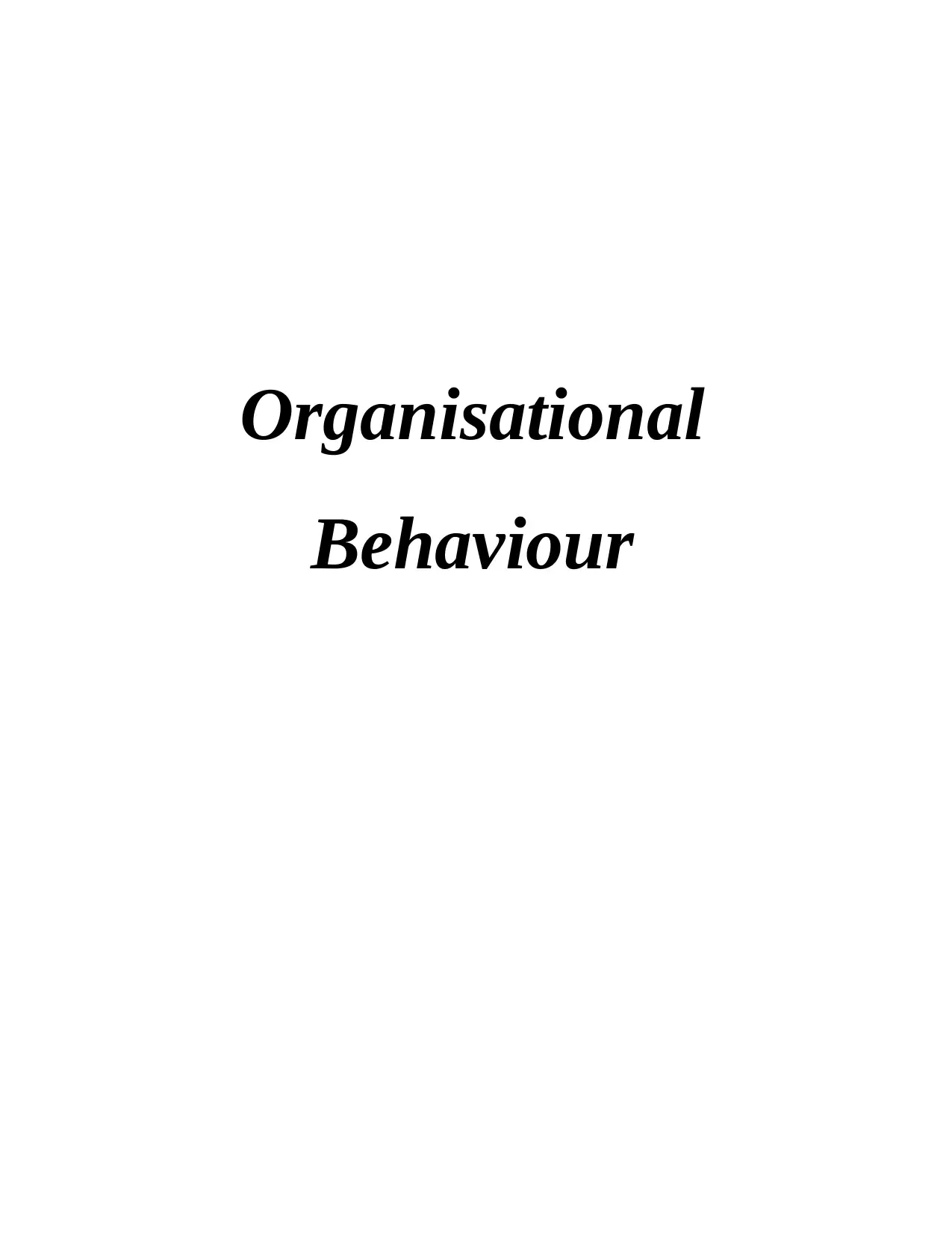
Organisational
Behaviour
Behaviour
Secure Best Marks with AI Grader
Need help grading? Try our AI Grader for instant feedback on your assignments.
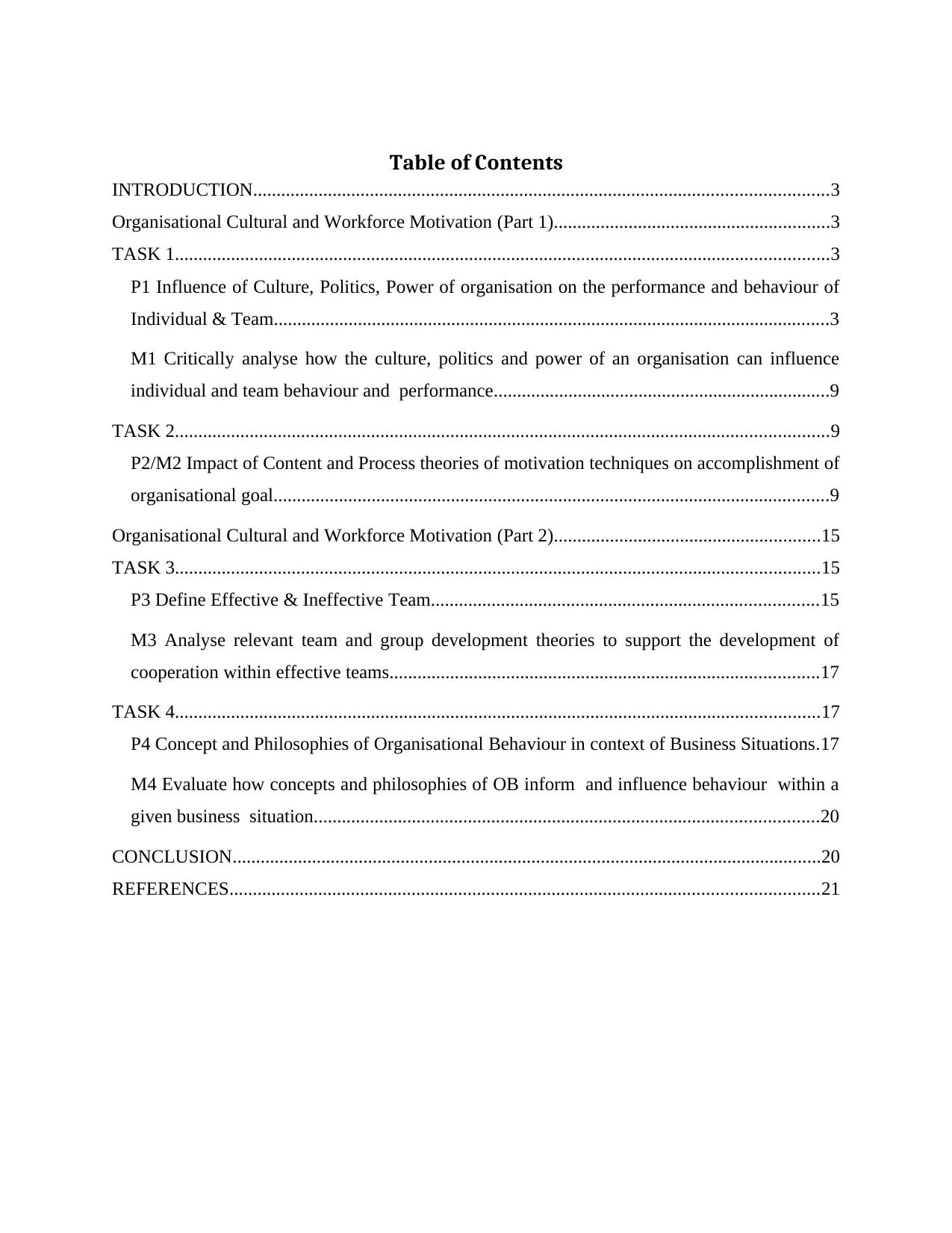
Table of Contents
INTRODUCTION...........................................................................................................................3
Organisational Cultural and Workforce Motivation (Part 1)...........................................................3
TASK 1............................................................................................................................................3
P1 Influence of Culture, Politics, Power of organisation on the performance and behaviour of
Individual & Team.......................................................................................................................3
M1 Critically analyse how the culture, politics and power of an organisation can influence
individual and team behaviour and performance........................................................................9
TASK 2............................................................................................................................................9
P2/M2 Impact of Content and Process theories of motivation techniques on accomplishment of
organisational goal.......................................................................................................................9
Organisational Cultural and Workforce Motivation (Part 2).........................................................15
TASK 3..........................................................................................................................................15
P3 Define Effective & Ineffective Team...................................................................................15
M3 Analyse relevant team and group development theories to support the development of
cooperation within effective teams............................................................................................17
TASK 4..........................................................................................................................................17
P4 Concept and Philosophies of Organisational Behaviour in context of Business Situations.17
M4 Evaluate how concepts and philosophies of OB inform and influence behaviour within a
given business situation............................................................................................................20
CONCLUSION..............................................................................................................................20
REFERENCES..............................................................................................................................21
INTRODUCTION...........................................................................................................................3
Organisational Cultural and Workforce Motivation (Part 1)...........................................................3
TASK 1............................................................................................................................................3
P1 Influence of Culture, Politics, Power of organisation on the performance and behaviour of
Individual & Team.......................................................................................................................3
M1 Critically analyse how the culture, politics and power of an organisation can influence
individual and team behaviour and performance........................................................................9
TASK 2............................................................................................................................................9
P2/M2 Impact of Content and Process theories of motivation techniques on accomplishment of
organisational goal.......................................................................................................................9
Organisational Cultural and Workforce Motivation (Part 2).........................................................15
TASK 3..........................................................................................................................................15
P3 Define Effective & Ineffective Team...................................................................................15
M3 Analyse relevant team and group development theories to support the development of
cooperation within effective teams............................................................................................17
TASK 4..........................................................................................................................................17
P4 Concept and Philosophies of Organisational Behaviour in context of Business Situations.17
M4 Evaluate how concepts and philosophies of OB inform and influence behaviour within a
given business situation............................................................................................................20
CONCLUSION..............................................................................................................................20
REFERENCES..............................................................................................................................21
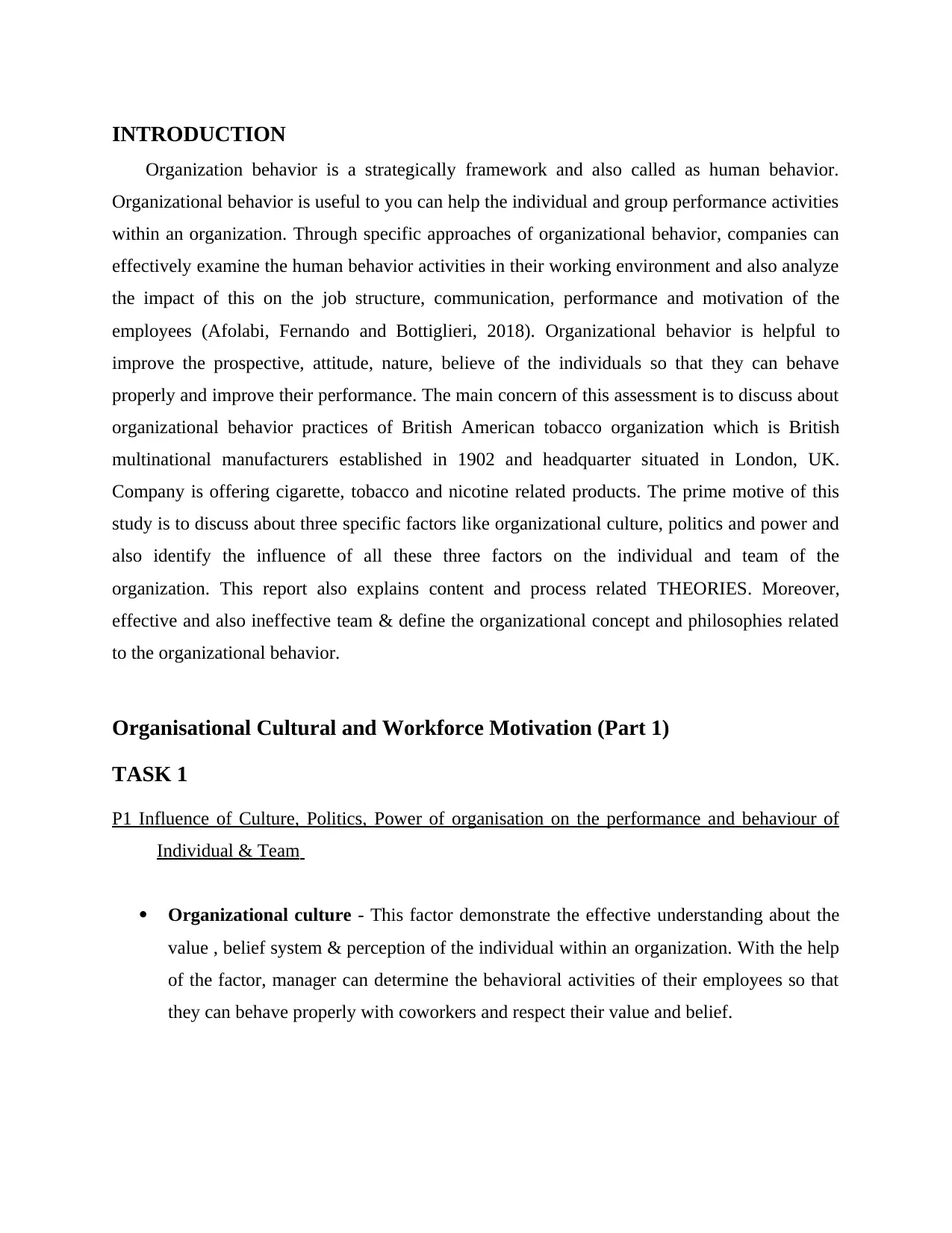
INTRODUCTION
Organization behavior is a strategically framework and also called as human behavior.
Organizational behavior is useful to you can help the individual and group performance activities
within an organization. Through specific approaches of organizational behavior, companies can
effectively examine the human behavior activities in their working environment and also analyze
the impact of this on the job structure, communication, performance and motivation of the
employees (Afolabi, Fernando and Bottiglieri, 2018). Organizational behavior is helpful to
improve the prospective, attitude, nature, believe of the individuals so that they can behave
properly and improve their performance. The main concern of this assessment is to discuss about
organizational behavior practices of British American tobacco organization which is British
multinational manufacturers established in 1902 and headquarter situated in London, UK.
Company is offering cigarette, tobacco and nicotine related products. The prime motive of this
study is to discuss about three specific factors like organizational culture, politics and power and
also identify the influence of all these three factors on the individual and team of the
organization. This report also explains content and process related THEORIES. Moreover,
effective and also ineffective team & define the organizational concept and philosophies related
to the organizational behavior.
Organisational Cultural and Workforce Motivation (Part 1)
TASK 1
P1 Influence of Culture, Politics, Power of organisation on the performance and behaviour of
Individual & Team
Organizational culture - This factor demonstrate the effective understanding about the
value , belief system & perception of the individual within an organization. With the help
of the factor, manager can determine the behavioral activities of their employees so that
they can behave properly with coworkers and respect their value and belief.
Organization behavior is a strategically framework and also called as human behavior.
Organizational behavior is useful to you can help the individual and group performance activities
within an organization. Through specific approaches of organizational behavior, companies can
effectively examine the human behavior activities in their working environment and also analyze
the impact of this on the job structure, communication, performance and motivation of the
employees (Afolabi, Fernando and Bottiglieri, 2018). Organizational behavior is helpful to
improve the prospective, attitude, nature, believe of the individuals so that they can behave
properly and improve their performance. The main concern of this assessment is to discuss about
organizational behavior practices of British American tobacco organization which is British
multinational manufacturers established in 1902 and headquarter situated in London, UK.
Company is offering cigarette, tobacco and nicotine related products. The prime motive of this
study is to discuss about three specific factors like organizational culture, politics and power and
also identify the influence of all these three factors on the individual and team of the
organization. This report also explains content and process related THEORIES. Moreover,
effective and also ineffective team & define the organizational concept and philosophies related
to the organizational behavior.
Organisational Cultural and Workforce Motivation (Part 1)
TASK 1
P1 Influence of Culture, Politics, Power of organisation on the performance and behaviour of
Individual & Team
Organizational culture - This factor demonstrate the effective understanding about the
value , belief system & perception of the individual within an organization. With the help
of the factor, manager can determine the behavioral activities of their employees so that
they can behave properly with coworkers and respect their value and belief.
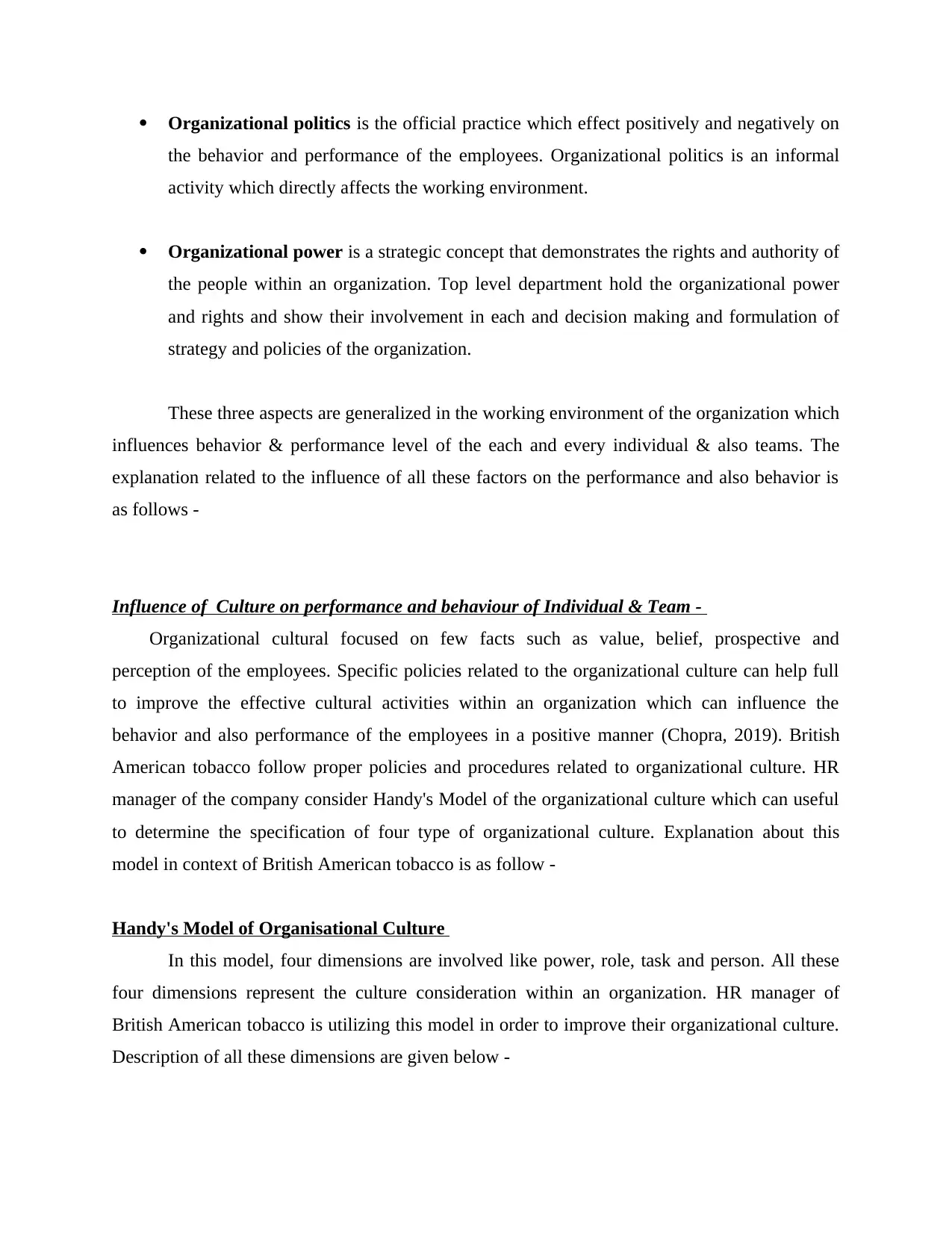
Organizational politics is the official practice which effect positively and negatively on
the behavior and performance of the employees. Organizational politics is an informal
activity which directly affects the working environment.
Organizational power is a strategic concept that demonstrates the rights and authority of
the people within an organization. Top level department hold the organizational power
and rights and show their involvement in each and decision making and formulation of
strategy and policies of the organization.
These three aspects are generalized in the working environment of the organization which
influences behavior & performance level of the each and every individual & also teams. The
explanation related to the influence of all these factors on the performance and also behavior is
as follows -
Influence of Culture on performance and behaviour of Individual & Team -
Organizational cultural focused on few facts such as value, belief, prospective and
perception of the employees. Specific policies related to the organizational culture can help full
to improve the effective cultural activities within an organization which can influence the
behavior and also performance of the employees in a positive manner (Chopra, 2019). British
American tobacco follow proper policies and procedures related to organizational culture. HR
manager of the company consider Handy's Model of the organizational culture which can useful
to determine the specification of four type of organizational culture. Explanation about this
model in context of British American tobacco is as follow -
Handy's Model of Organisational Culture
In this model, four dimensions are involved like power, role, task and person. All these
four dimensions represent the culture consideration within an organization. HR manager of
British American tobacco is utilizing this model in order to improve their organizational culture.
Description of all these dimensions are given below -
the behavior and performance of the employees. Organizational politics is an informal
activity which directly affects the working environment.
Organizational power is a strategic concept that demonstrates the rights and authority of
the people within an organization. Top level department hold the organizational power
and rights and show their involvement in each and decision making and formulation of
strategy and policies of the organization.
These three aspects are generalized in the working environment of the organization which
influences behavior & performance level of the each and every individual & also teams. The
explanation related to the influence of all these factors on the performance and also behavior is
as follows -
Influence of Culture on performance and behaviour of Individual & Team -
Organizational cultural focused on few facts such as value, belief, prospective and
perception of the employees. Specific policies related to the organizational culture can help full
to improve the effective cultural activities within an organization which can influence the
behavior and also performance of the employees in a positive manner (Chopra, 2019). British
American tobacco follow proper policies and procedures related to organizational culture. HR
manager of the company consider Handy's Model of the organizational culture which can useful
to determine the specification of four type of organizational culture. Explanation about this
model in context of British American tobacco is as follow -
Handy's Model of Organisational Culture
In this model, four dimensions are involved like power, role, task and person. All these
four dimensions represent the culture consideration within an organization. HR manager of
British American tobacco is utilizing this model in order to improve their organizational culture.
Description of all these dimensions are given below -
Secure Best Marks with AI Grader
Need help grading? Try our AI Grader for instant feedback on your assignments.
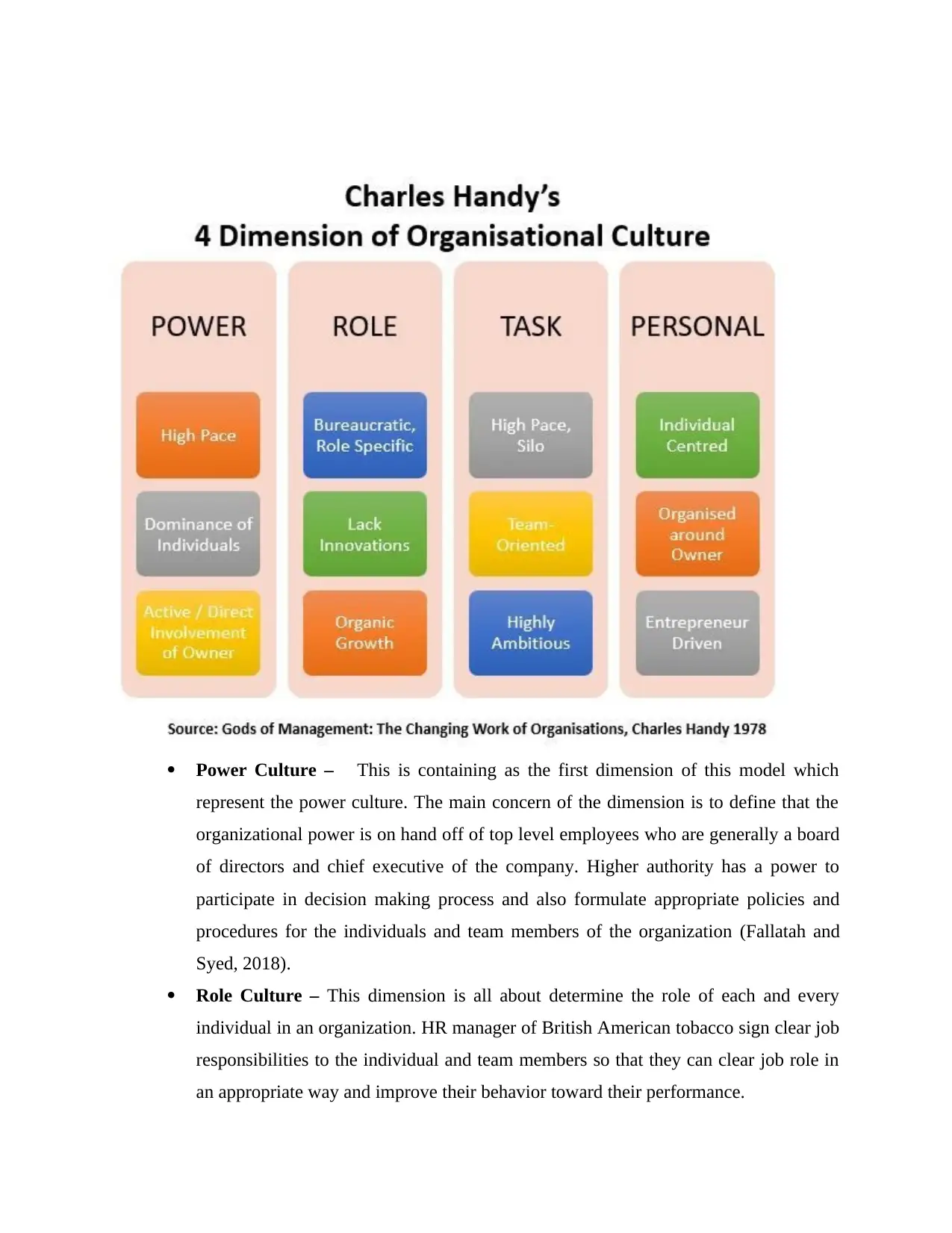
Power Culture – This is containing as the first dimension of this model which
represent the power culture. The main concern of the dimension is to define that the
organizational power is on hand off of top level employees who are generally a board
of directors and chief executive of the company. Higher authority has a power to
participate in decision making process and also formulate appropriate policies and
procedures for the individuals and team members of the organization (Fallatah and
Syed, 2018).
Role Culture – This dimension is all about determine the role of each and every
individual in an organization. HR manager of British American tobacco sign clear job
responsibilities to the individual and team members so that they can clear job role in
an appropriate way and improve their behavior toward their performance.
represent the power culture. The main concern of the dimension is to define that the
organizational power is on hand off of top level employees who are generally a board
of directors and chief executive of the company. Higher authority has a power to
participate in decision making process and also formulate appropriate policies and
procedures for the individuals and team members of the organization (Fallatah and
Syed, 2018).
Role Culture – This dimension is all about determine the role of each and every
individual in an organization. HR manager of British American tobacco sign clear job
responsibilities to the individual and team members so that they can clear job role in
an appropriate way and improve their behavior toward their performance.
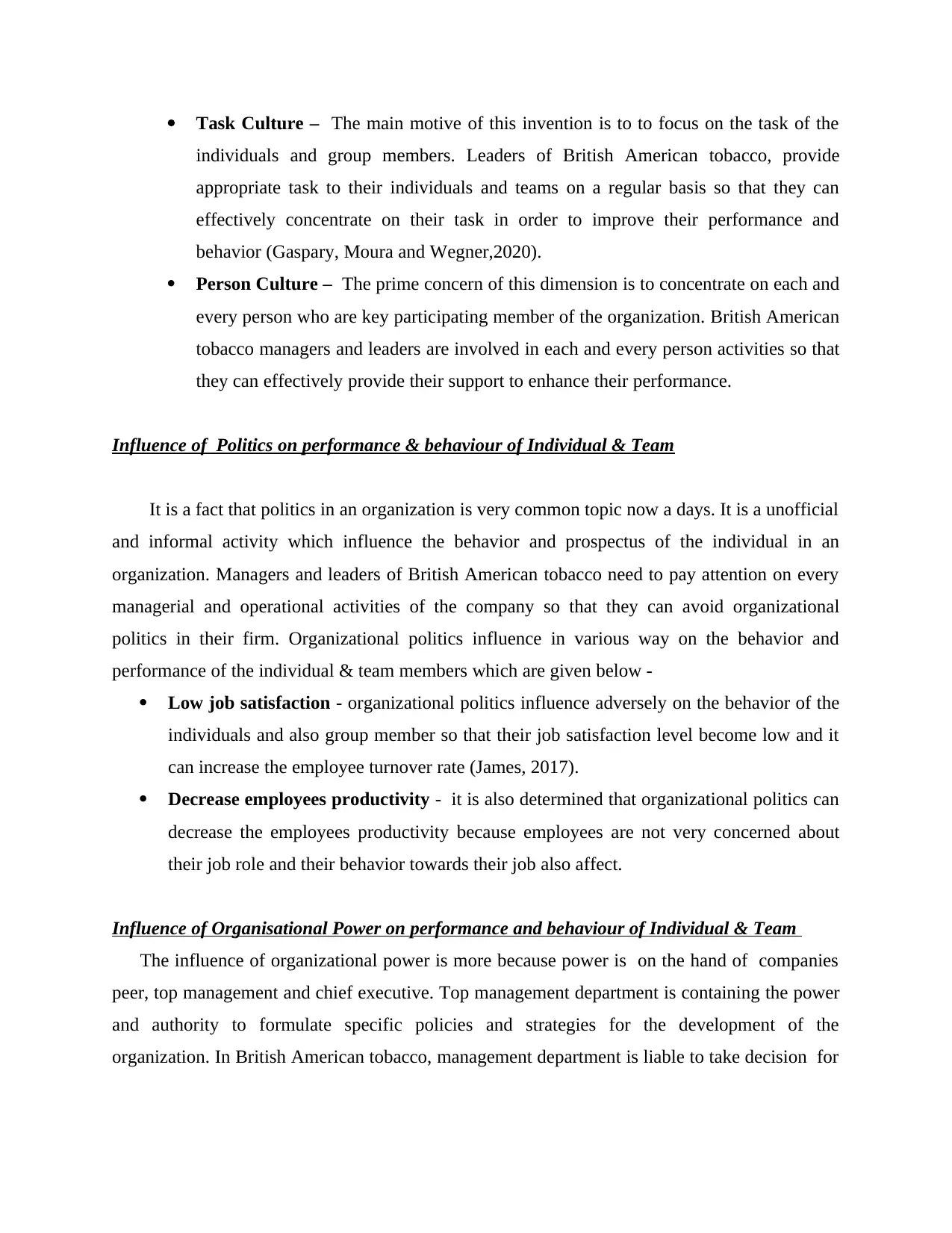
Task Culture – The main motive of this invention is to to focus on the task of the
individuals and group members. Leaders of British American tobacco, provide
appropriate task to their individuals and teams on a regular basis so that they can
effectively concentrate on their task in order to improve their performance and
behavior (Gaspary, Moura and Wegner,2020).
Person Culture – The prime concern of this dimension is to concentrate on each and
every person who are key participating member of the organization. British American
tobacco managers and leaders are involved in each and every person activities so that
they can effectively provide their support to enhance their performance.
Influence of Politics on performance & behaviour of Individual & Team
It is a fact that politics in an organization is very common topic now a days. It is a unofficial
and informal activity which influence the behavior and prospectus of the individual in an
organization. Managers and leaders of British American tobacco need to pay attention on every
managerial and operational activities of the company so that they can avoid organizational
politics in their firm. Organizational politics influence in various way on the behavior and
performance of the individual & team members which are given below -
Low job satisfaction - organizational politics influence adversely on the behavior of the
individuals and also group member so that their job satisfaction level become low and it
can increase the employee turnover rate (James, 2017).
Decrease employees productivity - it is also determined that organizational politics can
decrease the employees productivity because employees are not very concerned about
their job role and their behavior towards their job also affect.
Influence of Organisational Power on performance and behaviour of Individual & Team
The influence of organizational power is more because power is on the hand of companies
peer, top management and chief executive. Top management department is containing the power
and authority to formulate specific policies and strategies for the development of the
organization. In British American tobacco, management department is liable to take decision for
individuals and group members. Leaders of British American tobacco, provide
appropriate task to their individuals and teams on a regular basis so that they can
effectively concentrate on their task in order to improve their performance and
behavior (Gaspary, Moura and Wegner,2020).
Person Culture – The prime concern of this dimension is to concentrate on each and
every person who are key participating member of the organization. British American
tobacco managers and leaders are involved in each and every person activities so that
they can effectively provide their support to enhance their performance.
Influence of Politics on performance & behaviour of Individual & Team
It is a fact that politics in an organization is very common topic now a days. It is a unofficial
and informal activity which influence the behavior and prospectus of the individual in an
organization. Managers and leaders of British American tobacco need to pay attention on every
managerial and operational activities of the company so that they can avoid organizational
politics in their firm. Organizational politics influence in various way on the behavior and
performance of the individual & team members which are given below -
Low job satisfaction - organizational politics influence adversely on the behavior of the
individuals and also group member so that their job satisfaction level become low and it
can increase the employee turnover rate (James, 2017).
Decrease employees productivity - it is also determined that organizational politics can
decrease the employees productivity because employees are not very concerned about
their job role and their behavior towards their job also affect.
Influence of Organisational Power on performance and behaviour of Individual & Team
The influence of organizational power is more because power is on the hand of companies
peer, top management and chief executive. Top management department is containing the power
and authority to formulate specific policies and strategies for the development of the
organization. In British American tobacco, management department is liable to take decision for
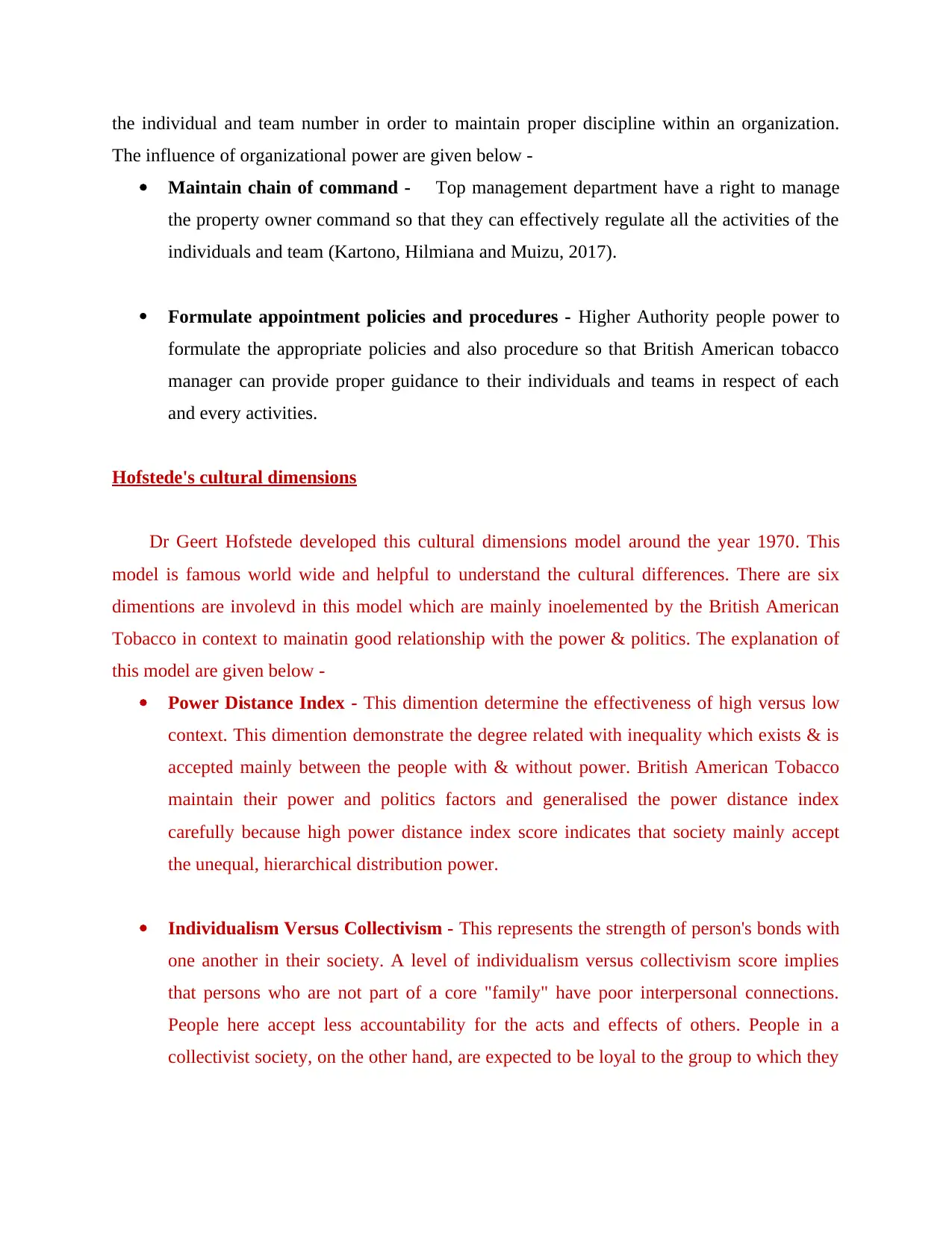
the individual and team number in order to maintain proper discipline within an organization.
The influence of organizational power are given below -
Maintain chain of command - Top management department have a right to manage
the property owner command so that they can effectively regulate all the activities of the
individuals and team (Kartono, Hilmiana and Muizu, 2017).
Formulate appointment policies and procedures - Higher Authority people power to
formulate the appropriate policies and also procedure so that British American tobacco
manager can provide proper guidance to their individuals and teams in respect of each
and every activities.
Hofstede's cultural dimensions
Dr Geert Hofstede developed this cultural dimensions model around the year 1970. This
model is famous world wide and helpful to understand the cultural differences. There are six
dimentions are involevd in this model which are mainly inoelemented by the British American
Tobacco in context to mainatin good relationship with the power & politics. The explanation of
this model are given below -
Power Distance Index - This dimention determine the effectiveness of high versus low
context. This dimention demonstrate the degree related with inequality which exists & is
accepted mainly between the people with & without power. British American Tobacco
maintain their power and politics factors and generalised the power distance index
carefully because high power distance index score indicates that society mainly accept
the unequal, hierarchical distribution power.
Individualism Versus Collectivism - This represents the strength of person's bonds with
one another in their society. A level of individualism versus collectivism score implies
that persons who are not part of a core "family" have poor interpersonal connections.
People here accept less accountability for the acts and effects of others. People in a
collectivist society, on the other hand, are expected to be loyal to the group to which they
The influence of organizational power are given below -
Maintain chain of command - Top management department have a right to manage
the property owner command so that they can effectively regulate all the activities of the
individuals and team (Kartono, Hilmiana and Muizu, 2017).
Formulate appointment policies and procedures - Higher Authority people power to
formulate the appropriate policies and also procedure so that British American tobacco
manager can provide proper guidance to their individuals and teams in respect of each
and every activities.
Hofstede's cultural dimensions
Dr Geert Hofstede developed this cultural dimensions model around the year 1970. This
model is famous world wide and helpful to understand the cultural differences. There are six
dimentions are involevd in this model which are mainly inoelemented by the British American
Tobacco in context to mainatin good relationship with the power & politics. The explanation of
this model are given below -
Power Distance Index - This dimention determine the effectiveness of high versus low
context. This dimention demonstrate the degree related with inequality which exists & is
accepted mainly between the people with & without power. British American Tobacco
maintain their power and politics factors and generalised the power distance index
carefully because high power distance index score indicates that society mainly accept
the unequal, hierarchical distribution power.
Individualism Versus Collectivism - This represents the strength of person's bonds with
one another in their society. A level of individualism versus collectivism score implies
that persons who are not part of a core "family" have poor interpersonal connections.
People here accept less accountability for the acts and effects of others. People in a
collectivist society, on the other hand, are expected to be loyal to the group to which they
Paraphrase This Document
Need a fresh take? Get an instant paraphrase of this document with our AI Paraphraser
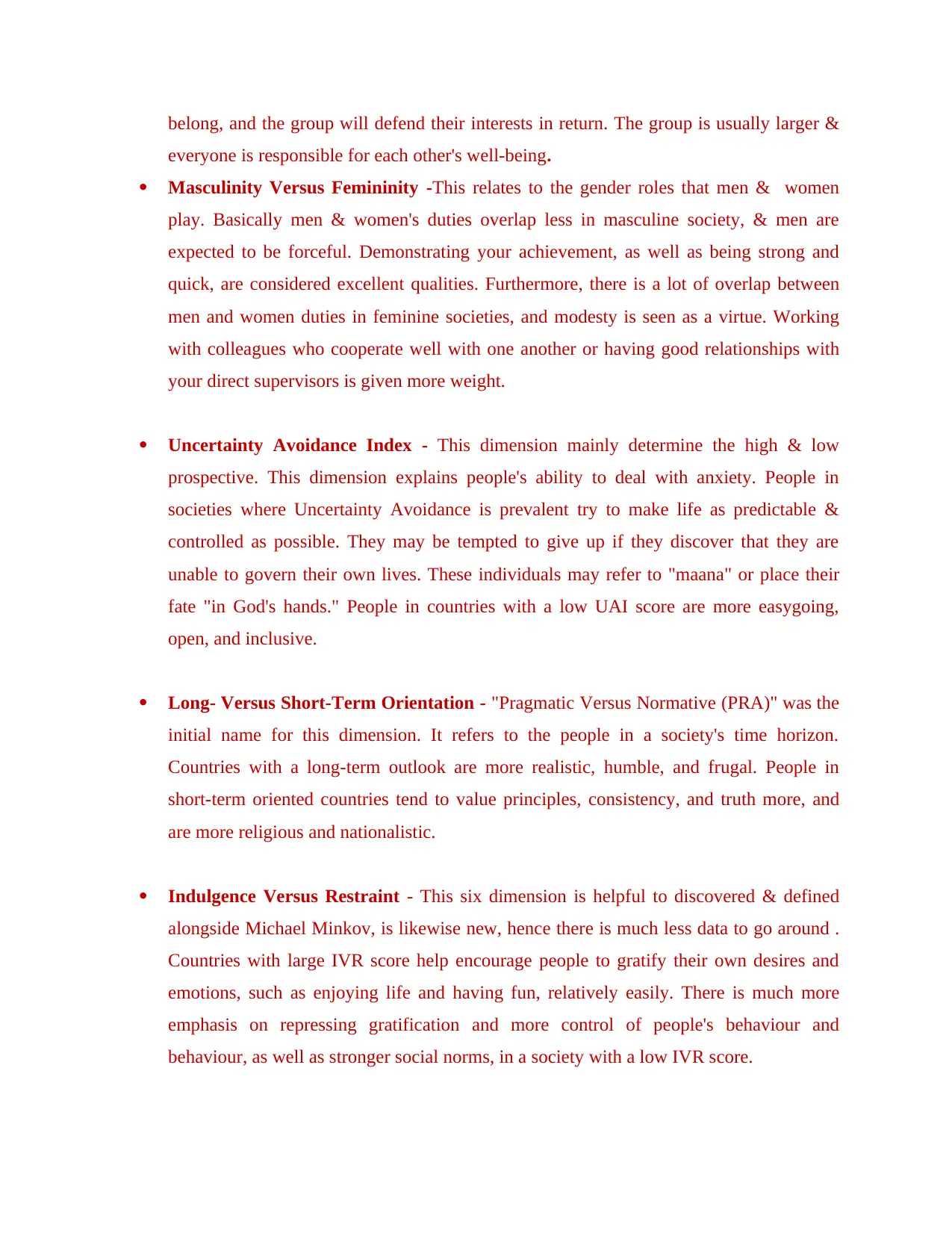
belong, and the group will defend their interests in return. The group is usually larger &
everyone is responsible for each other's well-being.
Masculinity Versus Femininity -This relates to the gender roles that men & women
play. Basically men & women's duties overlap less in masculine society, & men are
expected to be forceful. Demonstrating your achievement, as well as being strong and
quick, are considered excellent qualities. Furthermore, there is a lot of overlap between
men and women duties in feminine societies, and modesty is seen as a virtue. Working
with colleagues who cooperate well with one another or having good relationships with
your direct supervisors is given more weight.
Uncertainty Avoidance Index - This dimension mainly determine the high & low
prospective. This dimension explains people's ability to deal with anxiety. People in
societies where Uncertainty Avoidance is prevalent try to make life as predictable &
controlled as possible. They may be tempted to give up if they discover that they are
unable to govern their own lives. These individuals may refer to "maana" or place their
fate "in God's hands." People in countries with a low UAI score are more easygoing,
open, and inclusive.
Long- Versus Short-Term Orientation - "Pragmatic Versus Normative (PRA)" was the
initial name for this dimension. It refers to the people in a society's time horizon.
Countries with a long-term outlook are more realistic, humble, and frugal. People in
short-term oriented countries tend to value principles, consistency, and truth more, and
are more religious and nationalistic.
Indulgence Versus Restraint - This six dimension is helpful to discovered & defined
alongside Michael Minkov, is likewise new, hence there is much less data to go around .
Countries with large IVR score help encourage people to gratify their own desires and
emotions, such as enjoying life and having fun, relatively easily. There is much more
emphasis on repressing gratification and more control of people's behaviour and
behaviour, as well as stronger social norms, in a society with a low IVR score.
everyone is responsible for each other's well-being.
Masculinity Versus Femininity -This relates to the gender roles that men & women
play. Basically men & women's duties overlap less in masculine society, & men are
expected to be forceful. Demonstrating your achievement, as well as being strong and
quick, are considered excellent qualities. Furthermore, there is a lot of overlap between
men and women duties in feminine societies, and modesty is seen as a virtue. Working
with colleagues who cooperate well with one another or having good relationships with
your direct supervisors is given more weight.
Uncertainty Avoidance Index - This dimension mainly determine the high & low
prospective. This dimension explains people's ability to deal with anxiety. People in
societies where Uncertainty Avoidance is prevalent try to make life as predictable &
controlled as possible. They may be tempted to give up if they discover that they are
unable to govern their own lives. These individuals may refer to "maana" or place their
fate "in God's hands." People in countries with a low UAI score are more easygoing,
open, and inclusive.
Long- Versus Short-Term Orientation - "Pragmatic Versus Normative (PRA)" was the
initial name for this dimension. It refers to the people in a society's time horizon.
Countries with a long-term outlook are more realistic, humble, and frugal. People in
short-term oriented countries tend to value principles, consistency, and truth more, and
are more religious and nationalistic.
Indulgence Versus Restraint - This six dimension is helpful to discovered & defined
alongside Michael Minkov, is likewise new, hence there is much less data to go around .
Countries with large IVR score help encourage people to gratify their own desires and
emotions, such as enjoying life and having fun, relatively easily. There is much more
emphasis on repressing gratification and more control of people's behaviour and
behaviour, as well as stronger social norms, in a society with a low IVR score.
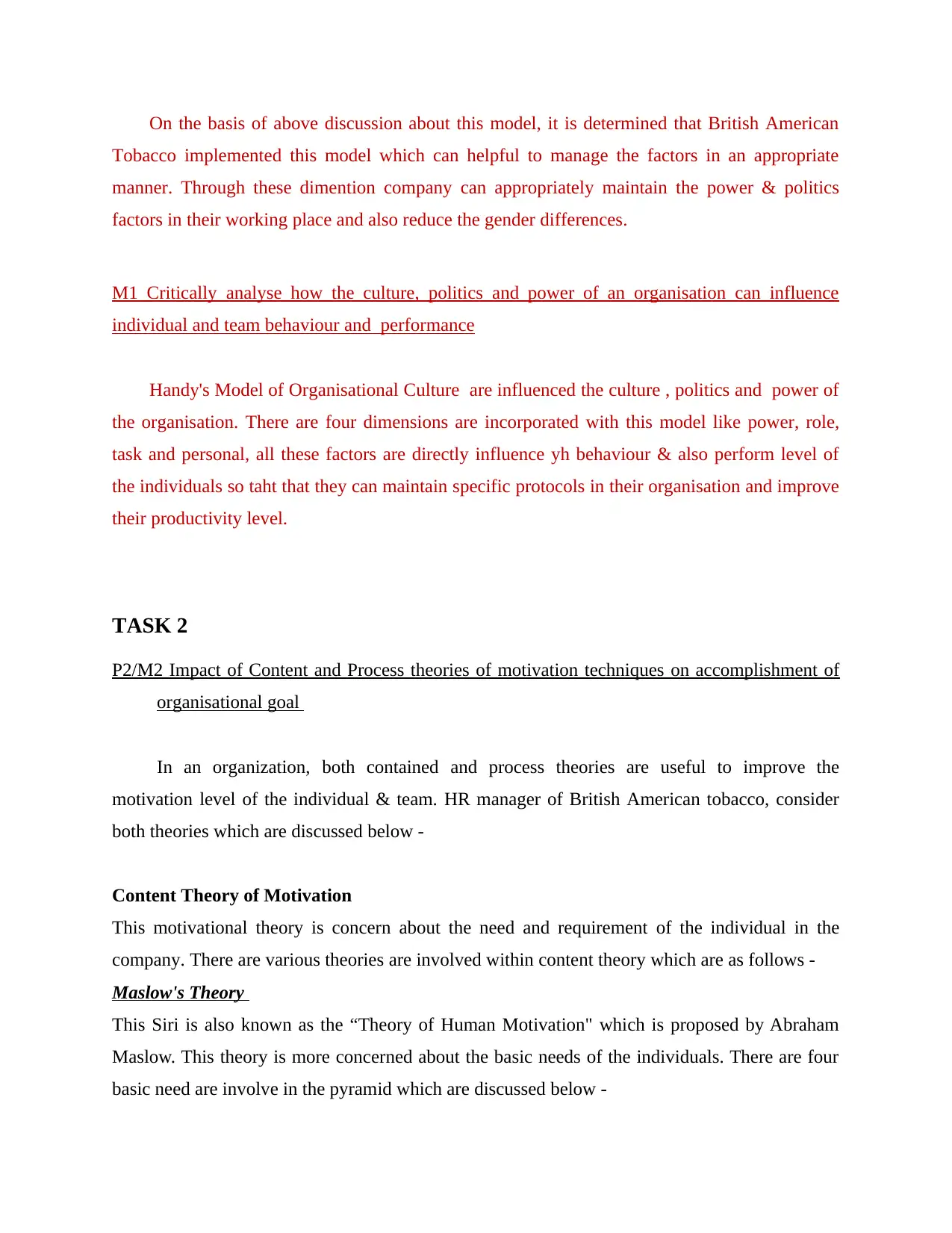
On the basis of above discussion about this model, it is determined that British American
Tobacco implemented this model which can helpful to manage the factors in an appropriate
manner. Through these dimention company can appropriately maintain the power & politics
factors in their working place and also reduce the gender differences.
M1 Critically analyse how the culture, politics and power of an organisation can influence
individual and team behaviour and performance
Handy's Model of Organisational Culture are influenced the culture , politics and power of
the organisation. There are four dimensions are incorporated with this model like power, role,
task and personal, all these factors are directly influence yh behaviour & also perform level of
the individuals so taht that they can maintain specific protocols in their organisation and improve
their productivity level.
TASK 2
P2/M2 Impact of Content and Process theories of motivation techniques on accomplishment of
organisational goal
In an organization, both contained and process theories are useful to improve the
motivation level of the individual & team. HR manager of British American tobacco, consider
both theories which are discussed below -
Content Theory of Motivation
This motivational theory is concern about the need and requirement of the individual in the
company. There are various theories are involved within content theory which are as follows -
Maslow's Theory
This Siri is also known as the “Theory of Human Motivation" which is proposed by Abraham
Maslow. This theory is more concerned about the basic needs of the individuals. There are four
basic need are involve in the pyramid which are discussed below -
Tobacco implemented this model which can helpful to manage the factors in an appropriate
manner. Through these dimention company can appropriately maintain the power & politics
factors in their working place and also reduce the gender differences.
M1 Critically analyse how the culture, politics and power of an organisation can influence
individual and team behaviour and performance
Handy's Model of Organisational Culture are influenced the culture , politics and power of
the organisation. There are four dimensions are incorporated with this model like power, role,
task and personal, all these factors are directly influence yh behaviour & also perform level of
the individuals so taht that they can maintain specific protocols in their organisation and improve
their productivity level.
TASK 2
P2/M2 Impact of Content and Process theories of motivation techniques on accomplishment of
organisational goal
In an organization, both contained and process theories are useful to improve the
motivation level of the individual & team. HR manager of British American tobacco, consider
both theories which are discussed below -
Content Theory of Motivation
This motivational theory is concern about the need and requirement of the individual in the
company. There are various theories are involved within content theory which are as follows -
Maslow's Theory
This Siri is also known as the “Theory of Human Motivation" which is proposed by Abraham
Maslow. This theory is more concerned about the basic needs of the individuals. There are four
basic need are involve in the pyramid which are discussed below -
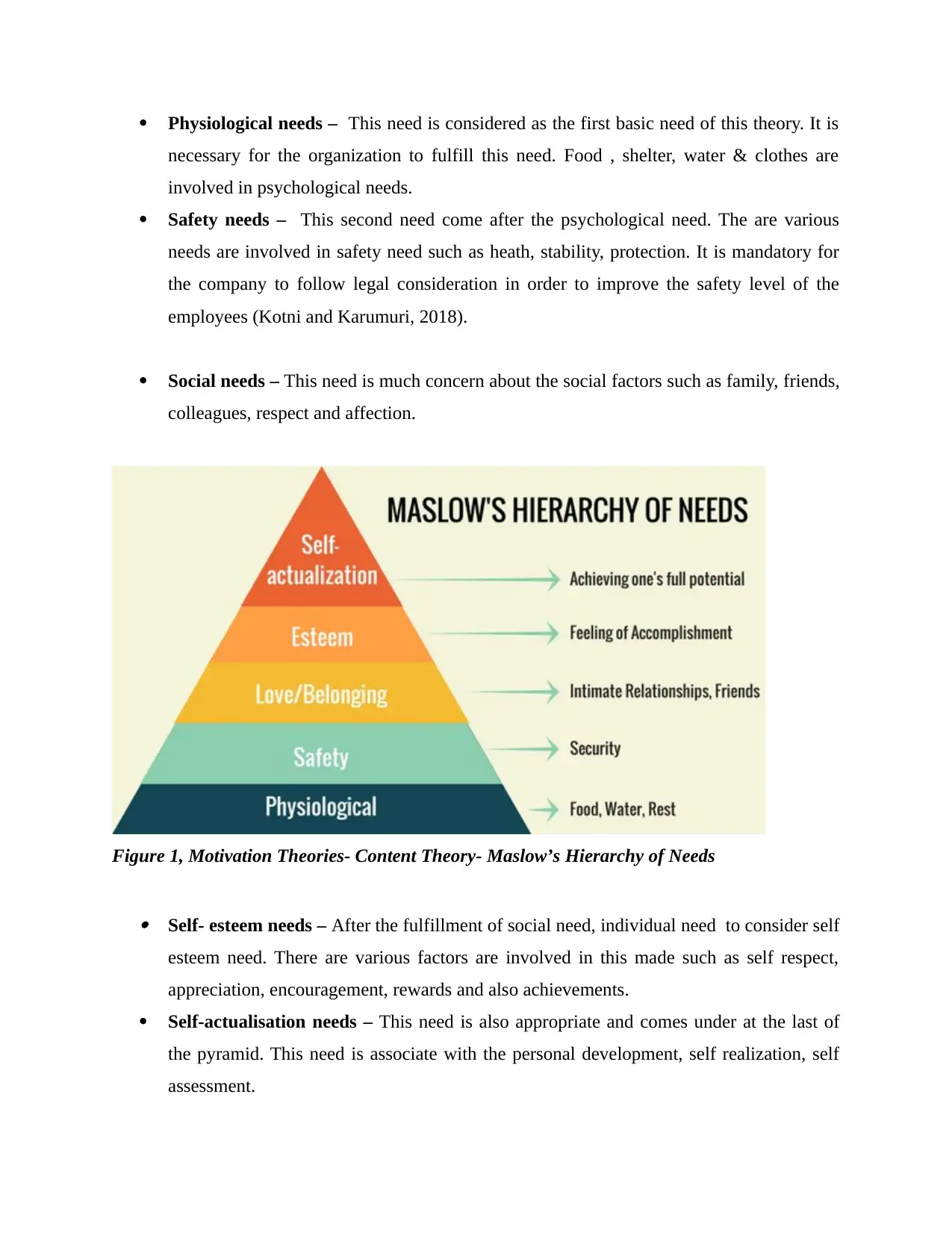
Physiological needs – This need is considered as the first basic need of this theory. It is
necessary for the organization to fulfill this need. Food , shelter, water & clothes are
involved in psychological needs.
Safety needs – This second need come after the psychological need. The are various
needs are involved in safety need such as heath, stability, protection. It is mandatory for
the company to follow legal consideration in order to improve the safety level of the
employees (Kotni and Karumuri, 2018).
Social needs – This need is much concern about the social factors such as family, friends,
colleagues, respect and affection.
Figure 1, Motivation Theories- Content Theory- Maslow’s Hierarchy of Needs
Self- esteem needs – After the fulfillment of social need, individual need to consider self
esteem need. There are various factors are involved in this made such as self respect,
appreciation, encouragement, rewards and also achievements.
Self-actualisation needs – This need is also appropriate and comes under at the last of
the pyramid. This need is associate with the personal development, self realization, self
assessment.
necessary for the organization to fulfill this need. Food , shelter, water & clothes are
involved in psychological needs.
Safety needs – This second need come after the psychological need. The are various
needs are involved in safety need such as heath, stability, protection. It is mandatory for
the company to follow legal consideration in order to improve the safety level of the
employees (Kotni and Karumuri, 2018).
Social needs – This need is much concern about the social factors such as family, friends,
colleagues, respect and affection.
Figure 1, Motivation Theories- Content Theory- Maslow’s Hierarchy of Needs
Self- esteem needs – After the fulfillment of social need, individual need to consider self
esteem need. There are various factors are involved in this made such as self respect,
appreciation, encouragement, rewards and also achievements.
Self-actualisation needs – This need is also appropriate and comes under at the last of
the pyramid. This need is associate with the personal development, self realization, self
assessment.
Secure Best Marks with AI Grader
Need help grading? Try our AI Grader for instant feedback on your assignments.
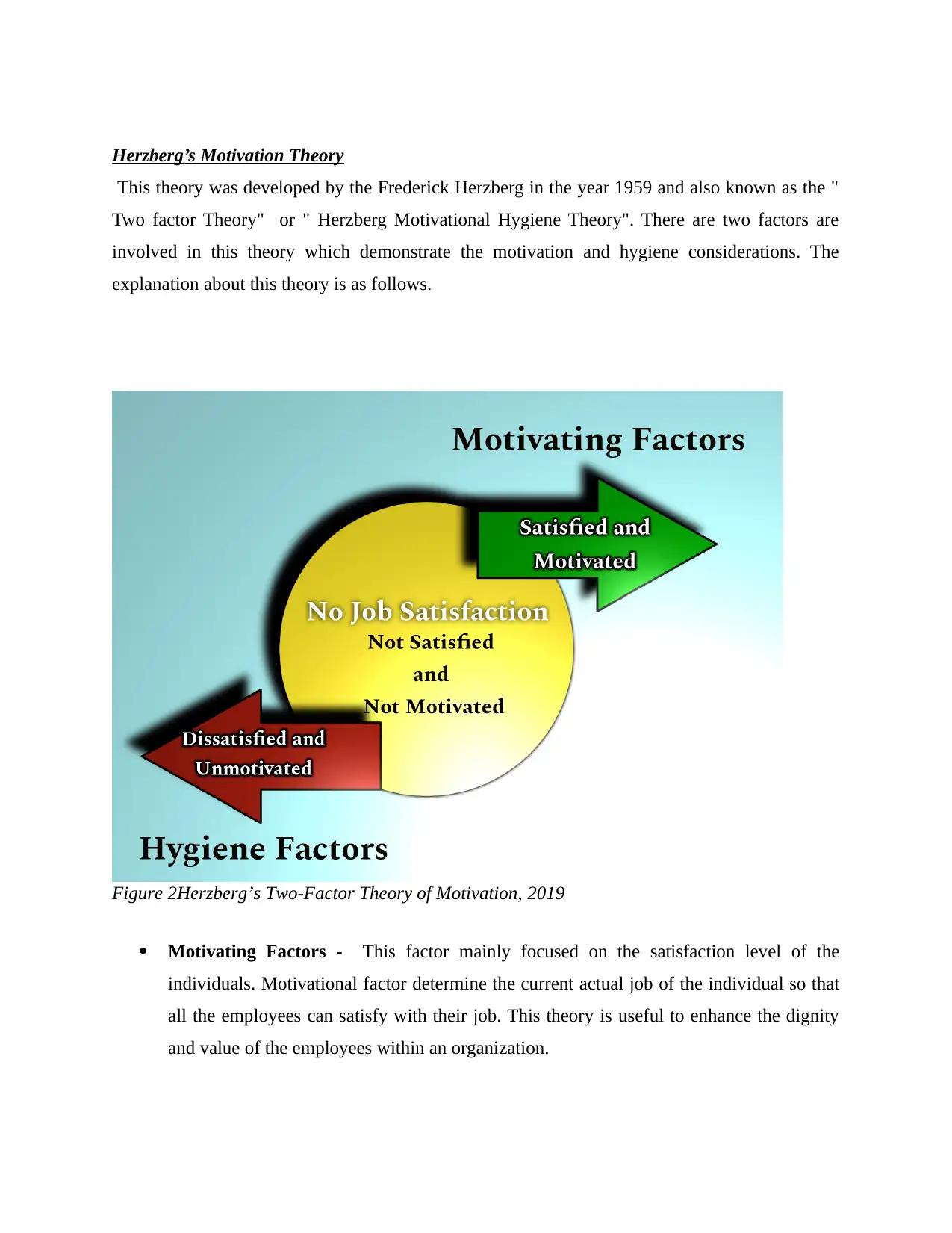
Herzberg’s Motivation Theory
This theory was developed by the Frederick Herzberg in the year 1959 and also known as the "
Two factor Theory" or " Herzberg Motivational Hygiene Theory". There are two factors are
involved in this theory which demonstrate the motivation and hygiene considerations. The
explanation about this theory is as follows.
Figure 2Herzberg’s Two-Factor Theory of Motivation, 2019
Motivating Factors - This factor mainly focused on the satisfaction level of the
individuals. Motivational factor determine the current actual job of the individual so that
all the employees can satisfy with their job. This theory is useful to enhance the dignity
and value of the employees within an organization.
This theory was developed by the Frederick Herzberg in the year 1959 and also known as the "
Two factor Theory" or " Herzberg Motivational Hygiene Theory". There are two factors are
involved in this theory which demonstrate the motivation and hygiene considerations. The
explanation about this theory is as follows.
Figure 2Herzberg’s Two-Factor Theory of Motivation, 2019
Motivating Factors - This factor mainly focused on the satisfaction level of the
individuals. Motivational factor determine the current actual job of the individual so that
all the employees can satisfy with their job. This theory is useful to enhance the dignity
and value of the employees within an organization.
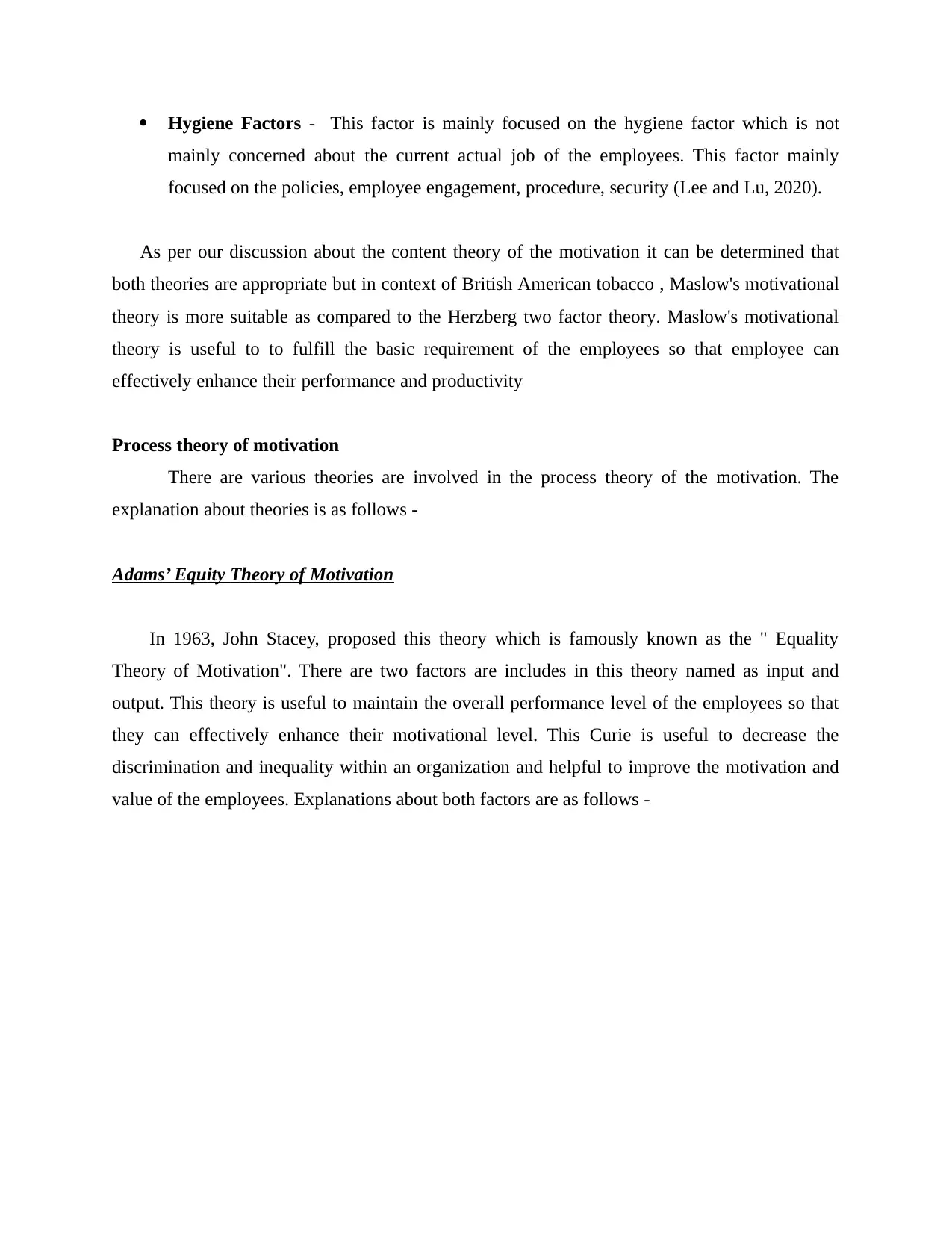
Hygiene Factors - This factor is mainly focused on the hygiene factor which is not
mainly concerned about the current actual job of the employees. This factor mainly
focused on the policies, employee engagement, procedure, security (Lee and Lu, 2020).
As per our discussion about the content theory of the motivation it can be determined that
both theories are appropriate but in context of British American tobacco , Maslow's motivational
theory is more suitable as compared to the Herzberg two factor theory. Maslow's motivational
theory is useful to to fulfill the basic requirement of the employees so that employee can
effectively enhance their performance and productivity
Process theory of motivation
There are various theories are involved in the process theory of the motivation. The
explanation about theories is as follows -
Adams’ Equity Theory of Motivation
In 1963, John Stacey, proposed this theory which is famously known as the " Equality
Theory of Motivation". There are two factors are includes in this theory named as input and
output. This theory is useful to maintain the overall performance level of the employees so that
they can effectively enhance their motivational level. This Curie is useful to decrease the
discrimination and inequality within an organization and helpful to improve the motivation and
value of the employees. Explanations about both factors are as follows -
mainly concerned about the current actual job of the employees. This factor mainly
focused on the policies, employee engagement, procedure, security (Lee and Lu, 2020).
As per our discussion about the content theory of the motivation it can be determined that
both theories are appropriate but in context of British American tobacco , Maslow's motivational
theory is more suitable as compared to the Herzberg two factor theory. Maslow's motivational
theory is useful to to fulfill the basic requirement of the employees so that employee can
effectively enhance their performance and productivity
Process theory of motivation
There are various theories are involved in the process theory of the motivation. The
explanation about theories is as follows -
Adams’ Equity Theory of Motivation
In 1963, John Stacey, proposed this theory which is famously known as the " Equality
Theory of Motivation". There are two factors are includes in this theory named as input and
output. This theory is useful to maintain the overall performance level of the employees so that
they can effectively enhance their motivational level. This Curie is useful to decrease the
discrimination and inequality within an organization and helpful to improve the motivation and
value of the employees. Explanations about both factors are as follows -
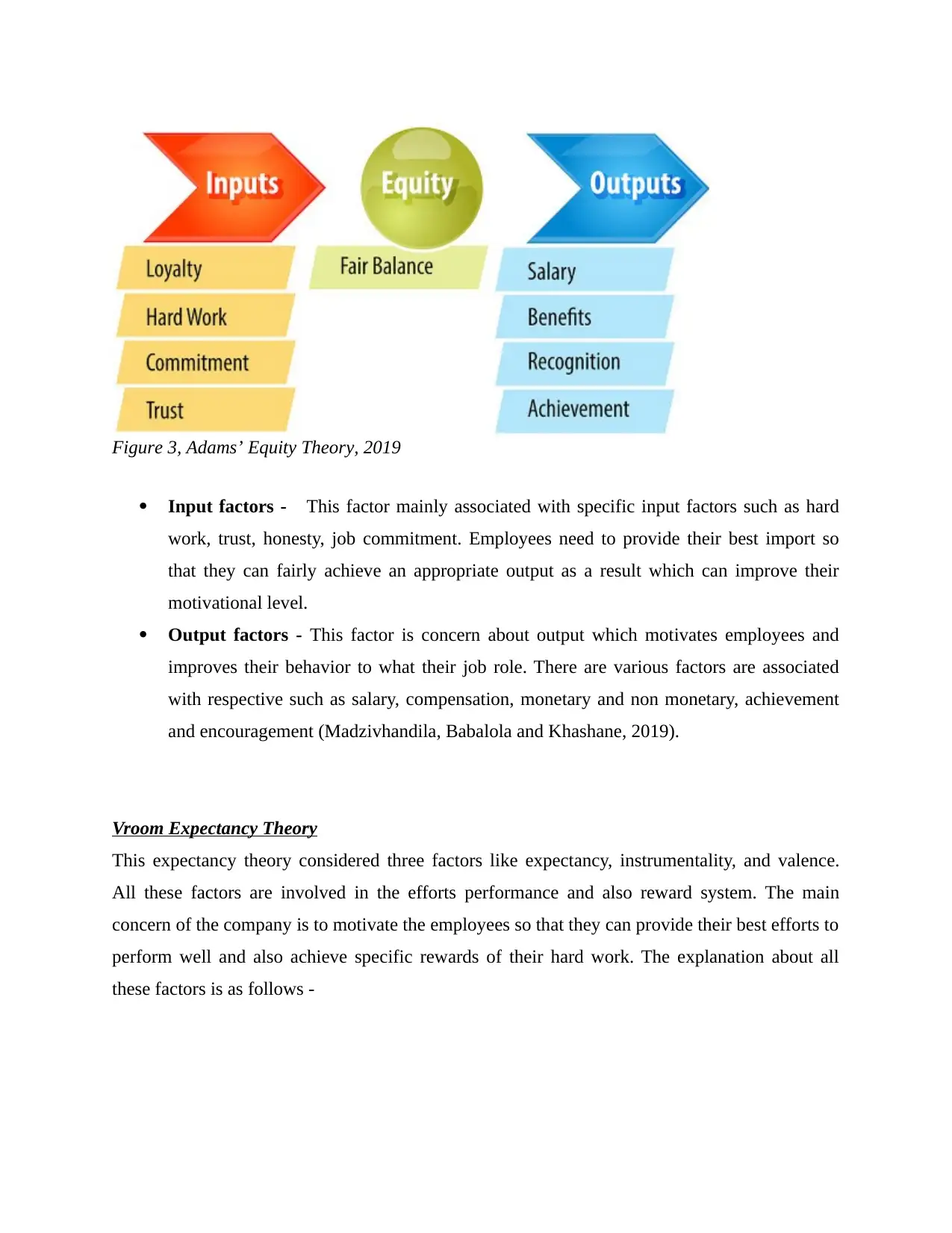
Figure 3, Adams’ Equity Theory, 2019
Input factors - This factor mainly associated with specific input factors such as hard
work, trust, honesty, job commitment. Employees need to provide their best import so
that they can fairly achieve an appropriate output as a result which can improve their
motivational level.
Output factors - This factor is concern about output which motivates employees and
improves their behavior to what their job role. There are various factors are associated
with respective such as salary, compensation, monetary and non monetary, achievement
and encouragement (Madzivhandila, Babalola and Khashane, 2019).
Vroom Expectancy Theory
This expectancy theory considered three factors like expectancy, instrumentality, and valence.
All these factors are involved in the efforts performance and also reward system. The main
concern of the company is to motivate the employees so that they can provide their best efforts to
perform well and also achieve specific rewards of their hard work. The explanation about all
these factors is as follows -
Input factors - This factor mainly associated with specific input factors such as hard
work, trust, honesty, job commitment. Employees need to provide their best import so
that they can fairly achieve an appropriate output as a result which can improve their
motivational level.
Output factors - This factor is concern about output which motivates employees and
improves their behavior to what their job role. There are various factors are associated
with respective such as salary, compensation, monetary and non monetary, achievement
and encouragement (Madzivhandila, Babalola and Khashane, 2019).
Vroom Expectancy Theory
This expectancy theory considered three factors like expectancy, instrumentality, and valence.
All these factors are involved in the efforts performance and also reward system. The main
concern of the company is to motivate the employees so that they can provide their best efforts to
perform well and also achieve specific rewards of their hard work. The explanation about all
these factors is as follows -
Paraphrase This Document
Need a fresh take? Get an instant paraphrase of this document with our AI Paraphraser
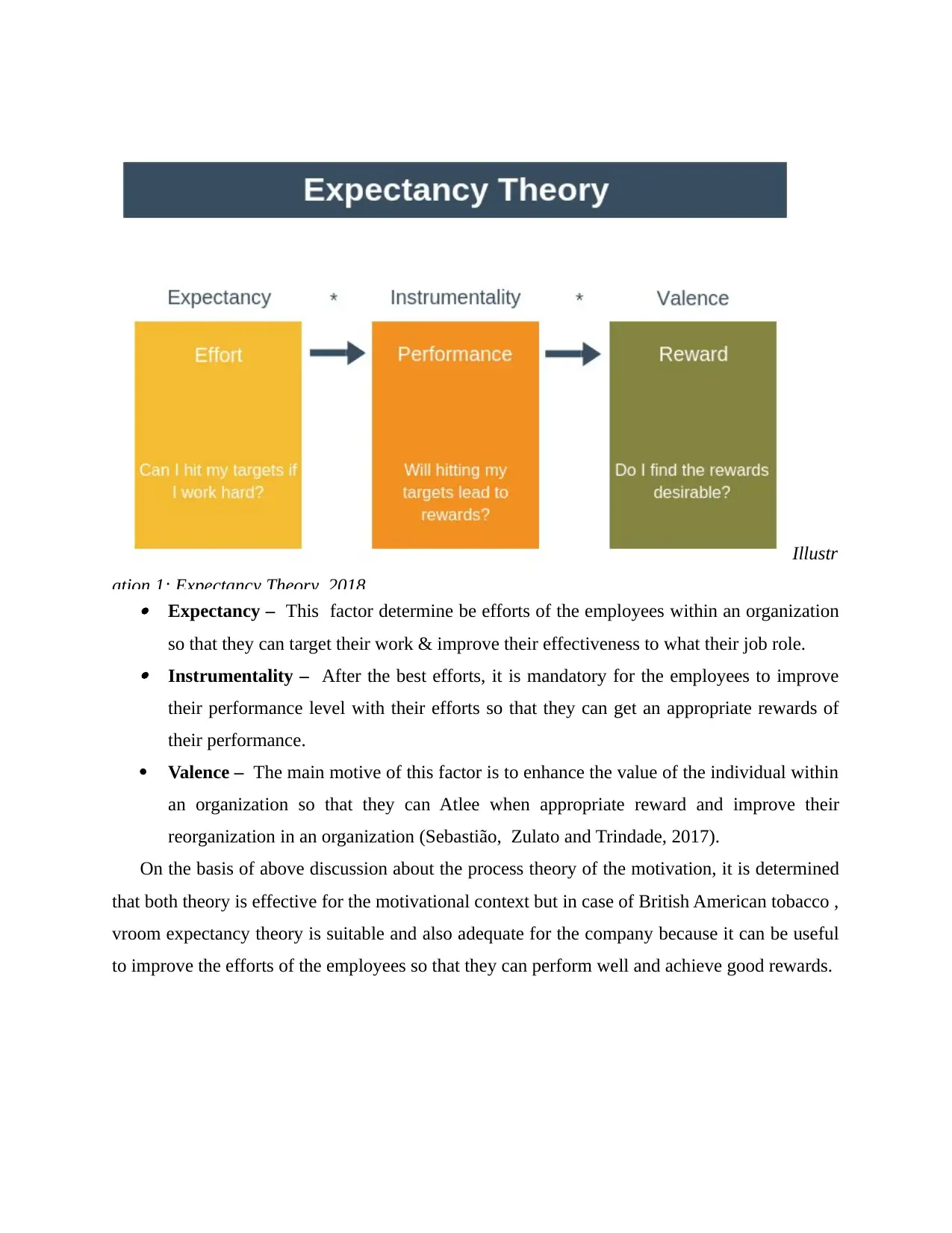
Expectancy – This factor determine be efforts of the employees within an organization
so that they can target their work & improve their effectiveness to what their job role. Instrumentality – After the best efforts, it is mandatory for the employees to improve
their performance level with their efforts so that they can get an appropriate rewards of
their performance.
Valence – The main motive of this factor is to enhance the value of the individual within
an organization so that they can Atlee when appropriate reward and improve their
reorganization in an organization (Sebastião, Zulato and Trindade, 2017).
On the basis of above discussion about the process theory of the motivation, it is determined
that both theory is effective for the motivational context but in case of British American tobacco ,
vroom expectancy theory is suitable and also adequate for the company because it can be useful
to improve the efforts of the employees so that they can perform well and achieve good rewards.
Illustr
ation 1: Expectancy Theory, 2018
so that they can target their work & improve their effectiveness to what their job role. Instrumentality – After the best efforts, it is mandatory for the employees to improve
their performance level with their efforts so that they can get an appropriate rewards of
their performance.
Valence – The main motive of this factor is to enhance the value of the individual within
an organization so that they can Atlee when appropriate reward and improve their
reorganization in an organization (Sebastião, Zulato and Trindade, 2017).
On the basis of above discussion about the process theory of the motivation, it is determined
that both theory is effective for the motivational context but in case of British American tobacco ,
vroom expectancy theory is suitable and also adequate for the company because it can be useful
to improve the efforts of the employees so that they can perform well and achieve good rewards.
Illustr
ation 1: Expectancy Theory, 2018
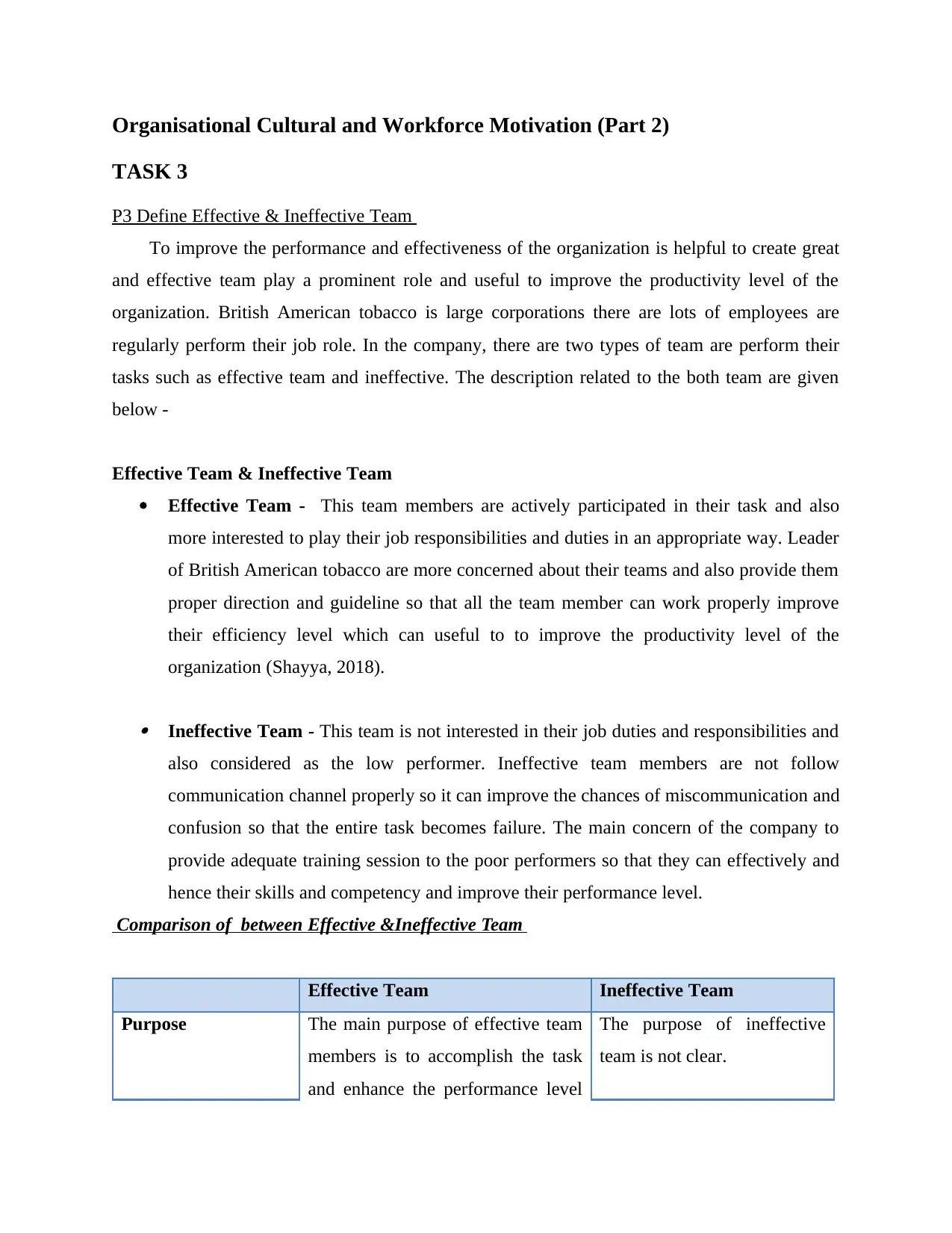
Organisational Cultural and Workforce Motivation (Part 2)
TASK 3
P3 Define Effective & Ineffective Team
To improve the performance and effectiveness of the organization is helpful to create great
and effective team play a prominent role and useful to improve the productivity level of the
organization. British American tobacco is large corporations there are lots of employees are
regularly perform their job role. In the company, there are two types of team are perform their
tasks such as effective team and ineffective. The description related to the both team are given
below -
Effective Team & Ineffective Team
Effective Team - This team members are actively participated in their task and also
more interested to play their job responsibilities and duties in an appropriate way. Leader
of British American tobacco are more concerned about their teams and also provide them
proper direction and guideline so that all the team member can work properly improve
their efficiency level which can useful to to improve the productivity level of the
organization (Shayya, 2018).
Ineffective Team - This team is not interested in their job duties and responsibilities and
also considered as the low performer. Ineffective team members are not follow
communication channel properly so it can improve the chances of miscommunication and
confusion so that the entire task becomes failure. The main concern of the company to
provide adequate training session to the poor performers so that they can effectively and
hence their skills and competency and improve their performance level.
Comparison of between Effective &Ineffective Team
Effective Team Ineffective Team
Purpose The main purpose of effective team
members is to accomplish the task
and enhance the performance level
The purpose of ineffective
team is not clear.
TASK 3
P3 Define Effective & Ineffective Team
To improve the performance and effectiveness of the organization is helpful to create great
and effective team play a prominent role and useful to improve the productivity level of the
organization. British American tobacco is large corporations there are lots of employees are
regularly perform their job role. In the company, there are two types of team are perform their
tasks such as effective team and ineffective. The description related to the both team are given
below -
Effective Team & Ineffective Team
Effective Team - This team members are actively participated in their task and also
more interested to play their job responsibilities and duties in an appropriate way. Leader
of British American tobacco are more concerned about their teams and also provide them
proper direction and guideline so that all the team member can work properly improve
their efficiency level which can useful to to improve the productivity level of the
organization (Shayya, 2018).
Ineffective Team - This team is not interested in their job duties and responsibilities and
also considered as the low performer. Ineffective team members are not follow
communication channel properly so it can improve the chances of miscommunication and
confusion so that the entire task becomes failure. The main concern of the company to
provide adequate training session to the poor performers so that they can effectively and
hence their skills and competency and improve their performance level.
Comparison of between Effective &Ineffective Team
Effective Team Ineffective Team
Purpose The main purpose of effective team
members is to accomplish the task
and enhance the performance level
The purpose of ineffective
team is not clear.
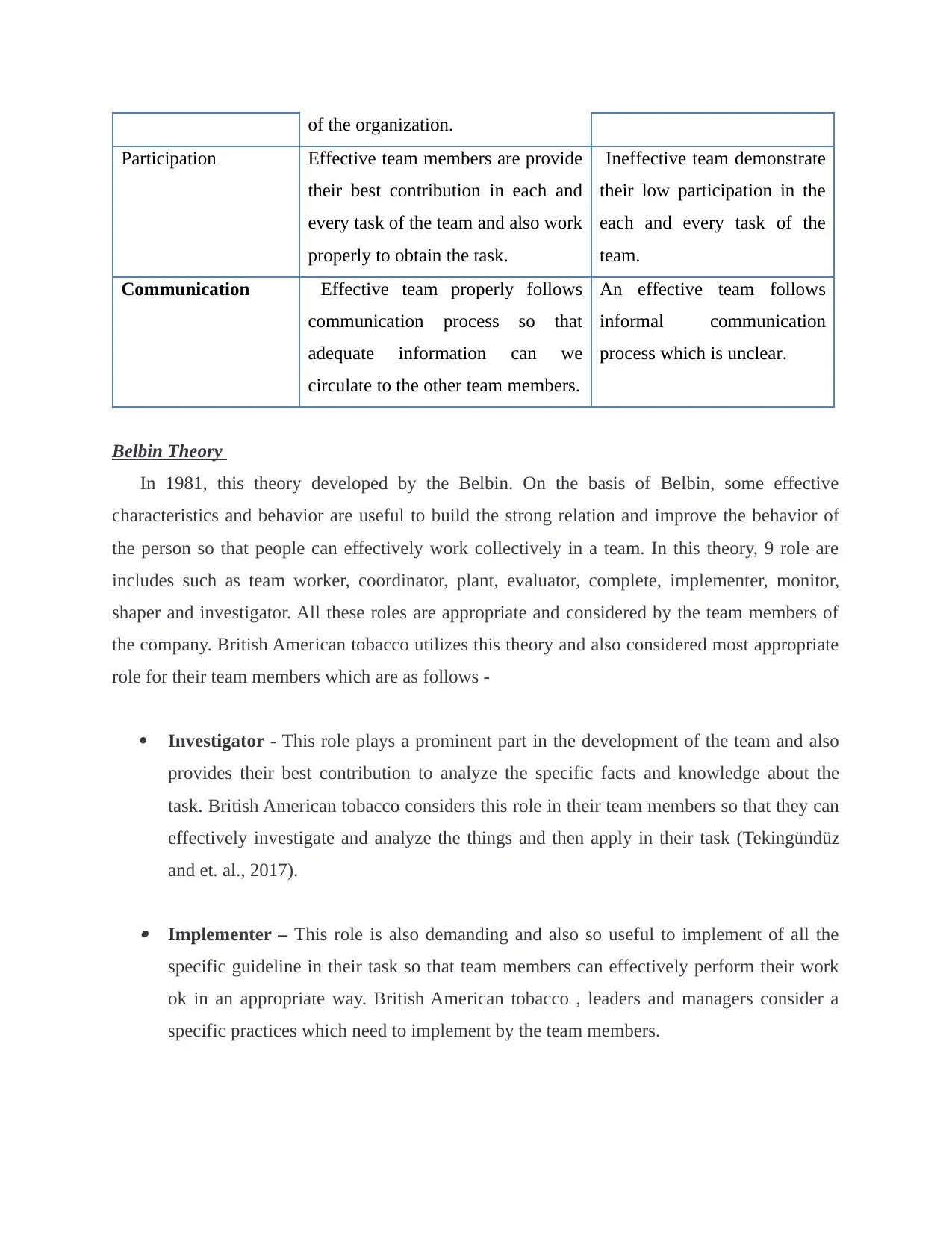
of the organization.
Participation Effective team members are provide
their best contribution in each and
every task of the team and also work
properly to obtain the task.
Ineffective team demonstrate
their low participation in the
each and every task of the
team.
Communication Effective team properly follows
communication process so that
adequate information can we
circulate to the other team members.
An effective team follows
informal communication
process which is unclear.
Belbin Theory
In 1981, this theory developed by the Belbin. On the basis of Belbin, some effective
characteristics and behavior are useful to build the strong relation and improve the behavior of
the person so that people can effectively work collectively in a team. In this theory, 9 role are
includes such as team worker, coordinator, plant, evaluator, complete, implementer, monitor,
shaper and investigator. All these roles are appropriate and considered by the team members of
the company. British American tobacco utilizes this theory and also considered most appropriate
role for their team members which are as follows -
Investigator - This role plays a prominent part in the development of the team and also
provides their best contribution to analyze the specific facts and knowledge about the
task. British American tobacco considers this role in their team members so that they can
effectively investigate and analyze the things and then apply in their task (Tekingündüz
and et. al., 2017).
Implementer – This role is also demanding and also so useful to implement of all the
specific guideline in their task so that team members can effectively perform their work
ok in an appropriate way. British American tobacco , leaders and managers consider a
specific practices which need to implement by the team members.
Participation Effective team members are provide
their best contribution in each and
every task of the team and also work
properly to obtain the task.
Ineffective team demonstrate
their low participation in the
each and every task of the
team.
Communication Effective team properly follows
communication process so that
adequate information can we
circulate to the other team members.
An effective team follows
informal communication
process which is unclear.
Belbin Theory
In 1981, this theory developed by the Belbin. On the basis of Belbin, some effective
characteristics and behavior are useful to build the strong relation and improve the behavior of
the person so that people can effectively work collectively in a team. In this theory, 9 role are
includes such as team worker, coordinator, plant, evaluator, complete, implementer, monitor,
shaper and investigator. All these roles are appropriate and considered by the team members of
the company. British American tobacco utilizes this theory and also considered most appropriate
role for their team members which are as follows -
Investigator - This role plays a prominent part in the development of the team and also
provides their best contribution to analyze the specific facts and knowledge about the
task. British American tobacco considers this role in their team members so that they can
effectively investigate and analyze the things and then apply in their task (Tekingündüz
and et. al., 2017).
Implementer – This role is also demanding and also so useful to implement of all the
specific guideline in their task so that team members can effectively perform their work
ok in an appropriate way. British American tobacco , leaders and managers consider a
specific practices which need to implement by the team members.
Secure Best Marks with AI Grader
Need help grading? Try our AI Grader for instant feedback on your assignments.
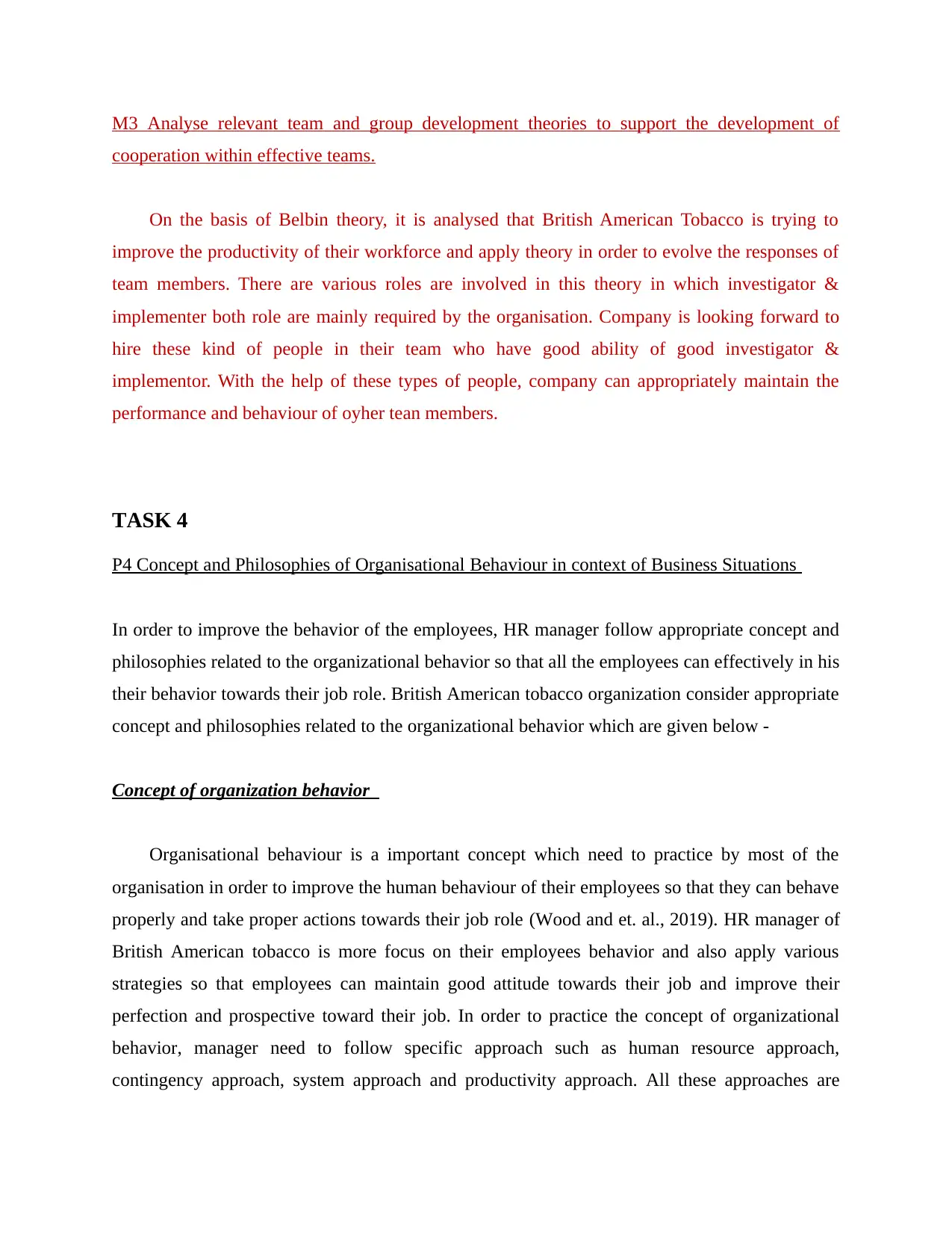
M3 Analyse relevant team and group development theories to support the development of
cooperation within effective teams.
On the basis of Belbin theory, it is analysed that British American Tobacco is trying to
improve the productivity of their workforce and apply theory in order to evolve the responses of
team members. There are various roles are involved in this theory in which investigator &
implementer both role are mainly required by the organisation. Company is looking forward to
hire these kind of people in their team who have good ability of good investigator &
implementor. With the help of these types of people, company can appropriately maintain the
performance and behaviour of oyher tean members.
TASK 4
P4 Concept and Philosophies of Organisational Behaviour in context of Business Situations
In order to improve the behavior of the employees, HR manager follow appropriate concept and
philosophies related to the organizational behavior so that all the employees can effectively in his
their behavior towards their job role. British American tobacco organization consider appropriate
concept and philosophies related to the organizational behavior which are given below -
Concept of organization behavior
Organisational behaviour is a important concept which need to practice by most of the
organisation in order to improve the human behaviour of their employees so that they can behave
properly and take proper actions towards their job role (Wood and et. al., 2019). HR manager of
British American tobacco is more focus on their employees behavior and also apply various
strategies so that employees can maintain good attitude towards their job and improve their
perfection and prospective toward their job. In order to practice the concept of organizational
behavior, manager need to follow specific approach such as human resource approach,
contingency approach, system approach and productivity approach. All these approaches are
cooperation within effective teams.
On the basis of Belbin theory, it is analysed that British American Tobacco is trying to
improve the productivity of their workforce and apply theory in order to evolve the responses of
team members. There are various roles are involved in this theory in which investigator &
implementer both role are mainly required by the organisation. Company is looking forward to
hire these kind of people in their team who have good ability of good investigator &
implementor. With the help of these types of people, company can appropriately maintain the
performance and behaviour of oyher tean members.
TASK 4
P4 Concept and Philosophies of Organisational Behaviour in context of Business Situations
In order to improve the behavior of the employees, HR manager follow appropriate concept and
philosophies related to the organizational behavior so that all the employees can effectively in his
their behavior towards their job role. British American tobacco organization consider appropriate
concept and philosophies related to the organizational behavior which are given below -
Concept of organization behavior
Organisational behaviour is a important concept which need to practice by most of the
organisation in order to improve the human behaviour of their employees so that they can behave
properly and take proper actions towards their job role (Wood and et. al., 2019). HR manager of
British American tobacco is more focus on their employees behavior and also apply various
strategies so that employees can maintain good attitude towards their job and improve their
perfection and prospective toward their job. In order to practice the concept of organizational
behavior, manager need to follow specific approach such as human resource approach,
contingency approach, system approach and productivity approach. All these approaches are
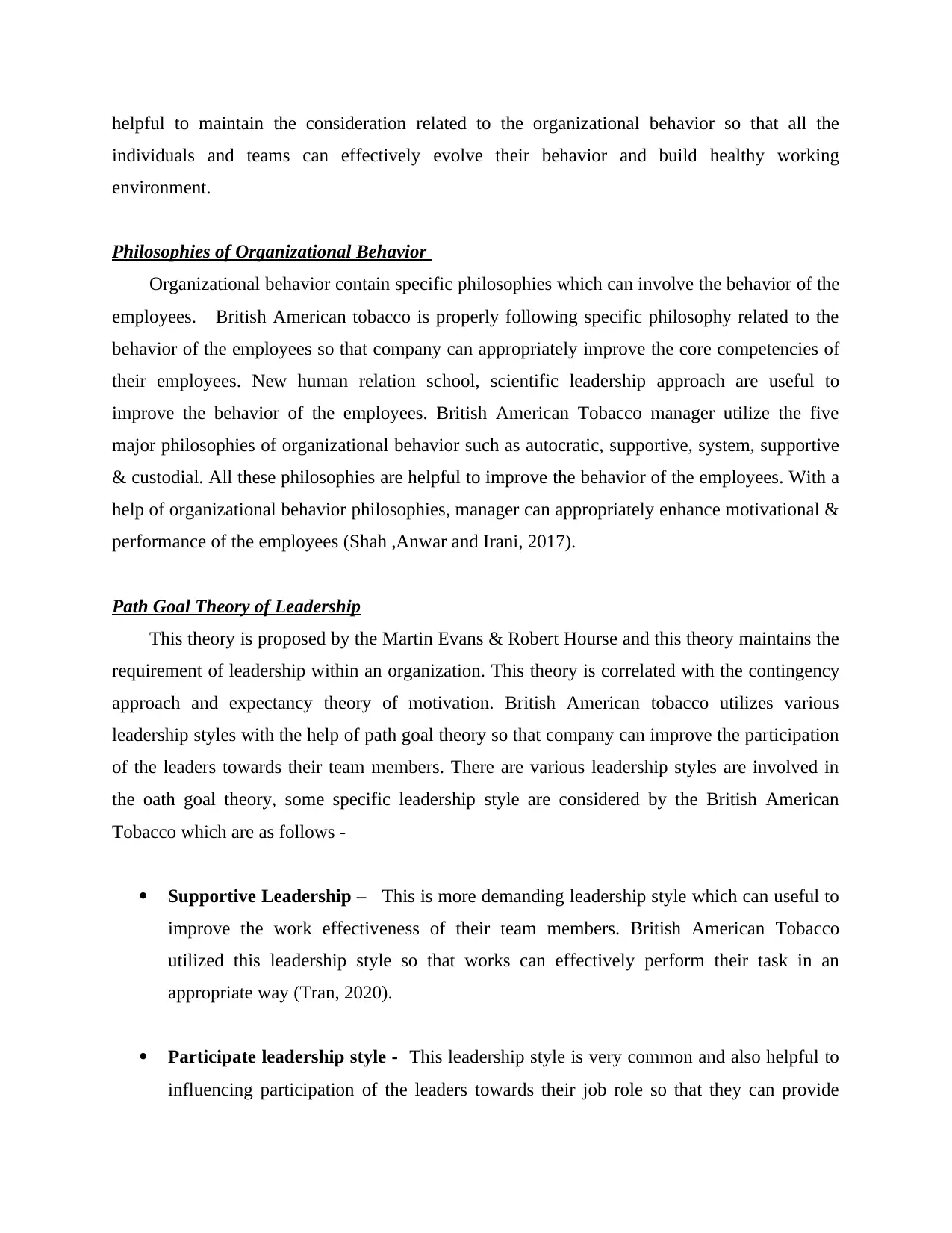
helpful to maintain the consideration related to the organizational behavior so that all the
individuals and teams can effectively evolve their behavior and build healthy working
environment.
Philosophies of Organizational Behavior
Organizational behavior contain specific philosophies which can involve the behavior of the
employees. British American tobacco is properly following specific philosophy related to the
behavior of the employees so that company can appropriately improve the core competencies of
their employees. New human relation school, scientific leadership approach are useful to
improve the behavior of the employees. British American Tobacco manager utilize the five
major philosophies of organizational behavior such as autocratic, supportive, system, supportive
& custodial. All these philosophies are helpful to improve the behavior of the employees. With a
help of organizational behavior philosophies, manager can appropriately enhance motivational &
performance of the employees (Shah ,Anwar and Irani, 2017).
Path Goal Theory of Leadership
This theory is proposed by the Martin Evans & Robert Hourse and this theory maintains the
requirement of leadership within an organization. This theory is correlated with the contingency
approach and expectancy theory of motivation. British American tobacco utilizes various
leadership styles with the help of path goal theory so that company can improve the participation
of the leaders towards their team members. There are various leadership styles are involved in
the oath goal theory, some specific leadership style are considered by the British American
Tobacco which are as follows -
Supportive Leadership – This is more demanding leadership style which can useful to
improve the work effectiveness of their team members. British American Tobacco
utilized this leadership style so that works can effectively perform their task in an
appropriate way (Tran, 2020).
Participate leadership style - This leadership style is very common and also helpful to
influencing participation of the leaders towards their job role so that they can provide
individuals and teams can effectively evolve their behavior and build healthy working
environment.
Philosophies of Organizational Behavior
Organizational behavior contain specific philosophies which can involve the behavior of the
employees. British American tobacco is properly following specific philosophy related to the
behavior of the employees so that company can appropriately improve the core competencies of
their employees. New human relation school, scientific leadership approach are useful to
improve the behavior of the employees. British American Tobacco manager utilize the five
major philosophies of organizational behavior such as autocratic, supportive, system, supportive
& custodial. All these philosophies are helpful to improve the behavior of the employees. With a
help of organizational behavior philosophies, manager can appropriately enhance motivational &
performance of the employees (Shah ,Anwar and Irani, 2017).
Path Goal Theory of Leadership
This theory is proposed by the Martin Evans & Robert Hourse and this theory maintains the
requirement of leadership within an organization. This theory is correlated with the contingency
approach and expectancy theory of motivation. British American tobacco utilizes various
leadership styles with the help of path goal theory so that company can improve the participation
of the leaders towards their team members. There are various leadership styles are involved in
the oath goal theory, some specific leadership style are considered by the British American
Tobacco which are as follows -
Supportive Leadership – This is more demanding leadership style which can useful to
improve the work effectiveness of their team members. British American Tobacco
utilized this leadership style so that works can effectively perform their task in an
appropriate way (Tran, 2020).
Participate leadership style - This leadership style is very common and also helpful to
influencing participation of the leaders towards their job role so that they can provide
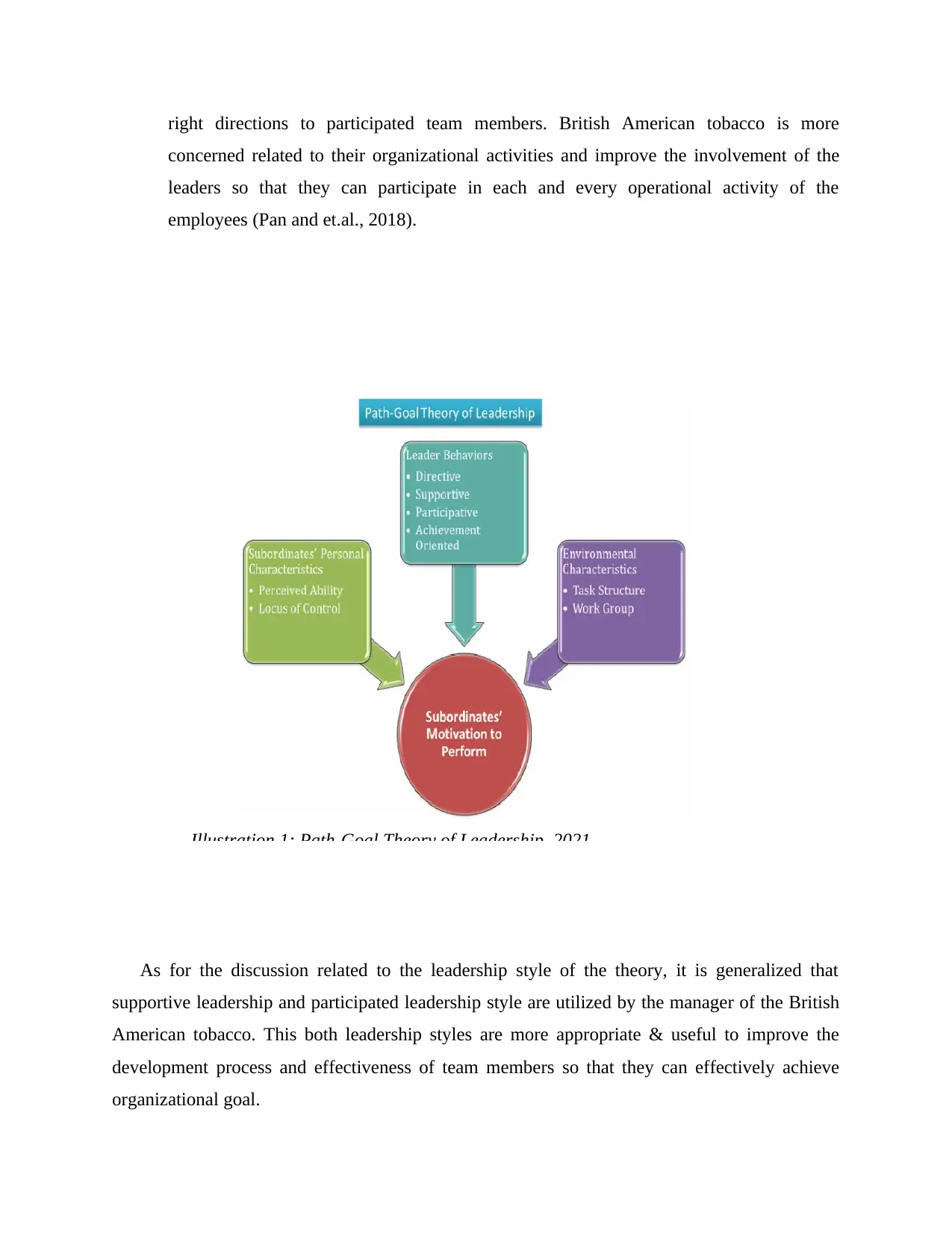
right directions to participated team members. British American tobacco is more
concerned related to their organizational activities and improve the involvement of the
leaders so that they can participate in each and every operational activity of the
employees (Pan and et.al., 2018).
As for the discussion related to the leadership style of the theory, it is generalized that
supportive leadership and participated leadership style are utilized by the manager of the British
American tobacco. This both leadership styles are more appropriate & useful to improve the
development process and effectiveness of team members so that they can effectively achieve
organizational goal.
Illustration 1: Path-Goal Theory of Leadership, 2021
concerned related to their organizational activities and improve the involvement of the
leaders so that they can participate in each and every operational activity of the
employees (Pan and et.al., 2018).
As for the discussion related to the leadership style of the theory, it is generalized that
supportive leadership and participated leadership style are utilized by the manager of the British
American tobacco. This both leadership styles are more appropriate & useful to improve the
development process and effectiveness of team members so that they can effectively achieve
organizational goal.
Illustration 1: Path-Goal Theory of Leadership, 2021
Paraphrase This Document
Need a fresh take? Get an instant paraphrase of this document with our AI Paraphraser
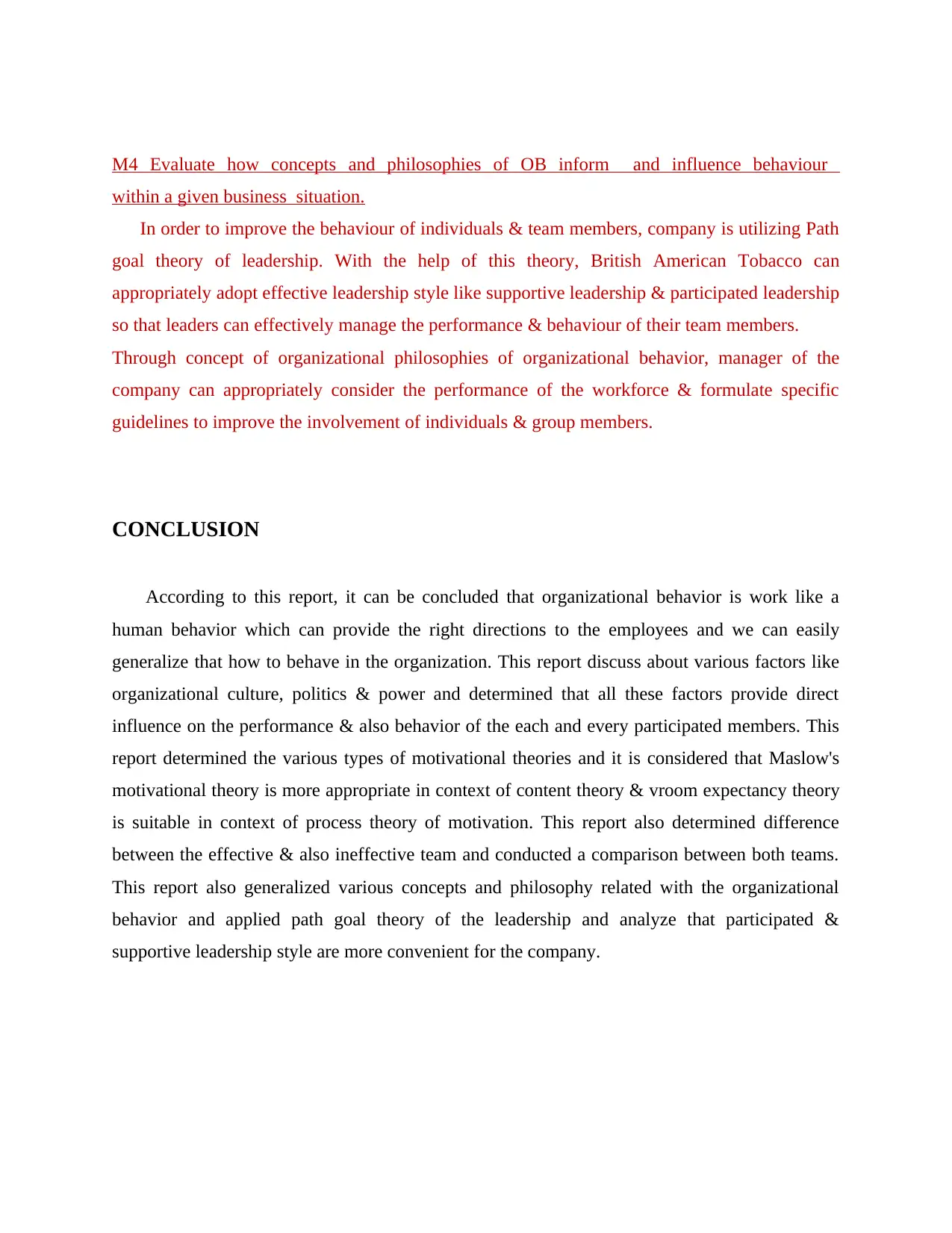
M4 Evaluate how concepts and philosophies of OB inform and influence behaviour
within a given business situation.
In order to improve the behaviour of individuals & team members, company is utilizing Path
goal theory of leadership. With the help of this theory, British American Tobacco can
appropriately adopt effective leadership style like supportive leadership & participated leadership
so that leaders can effectively manage the performance & behaviour of their team members.
Through concept of organizational philosophies of organizational behavior, manager of the
company can appropriately consider the performance of the workforce & formulate specific
guidelines to improve the involvement of individuals & group members.
CONCLUSION
According to this report, it can be concluded that organizational behavior is work like a
human behavior which can provide the right directions to the employees and we can easily
generalize that how to behave in the organization. This report discuss about various factors like
organizational culture, politics & power and determined that all these factors provide direct
influence on the performance & also behavior of the each and every participated members. This
report determined the various types of motivational theories and it is considered that Maslow's
motivational theory is more appropriate in context of content theory & vroom expectancy theory
is suitable in context of process theory of motivation. This report also determined difference
between the effective & also ineffective team and conducted a comparison between both teams.
This report also generalized various concepts and philosophy related with the organizational
behavior and applied path goal theory of the leadership and analyze that participated &
supportive leadership style are more convenient for the company.
within a given business situation.
In order to improve the behaviour of individuals & team members, company is utilizing Path
goal theory of leadership. With the help of this theory, British American Tobacco can
appropriately adopt effective leadership style like supportive leadership & participated leadership
so that leaders can effectively manage the performance & behaviour of their team members.
Through concept of organizational philosophies of organizational behavior, manager of the
company can appropriately consider the performance of the workforce & formulate specific
guidelines to improve the involvement of individuals & group members.
CONCLUSION
According to this report, it can be concluded that organizational behavior is work like a
human behavior which can provide the right directions to the employees and we can easily
generalize that how to behave in the organization. This report discuss about various factors like
organizational culture, politics & power and determined that all these factors provide direct
influence on the performance & also behavior of the each and every participated members. This
report determined the various types of motivational theories and it is considered that Maslow's
motivational theory is more appropriate in context of content theory & vroom expectancy theory
is suitable in context of process theory of motivation. This report also determined difference
between the effective & also ineffective team and conducted a comparison between both teams.
This report also generalized various concepts and philosophy related with the organizational
behavior and applied path goal theory of the leadership and analyze that participated &
supportive leadership style are more convenient for the company.
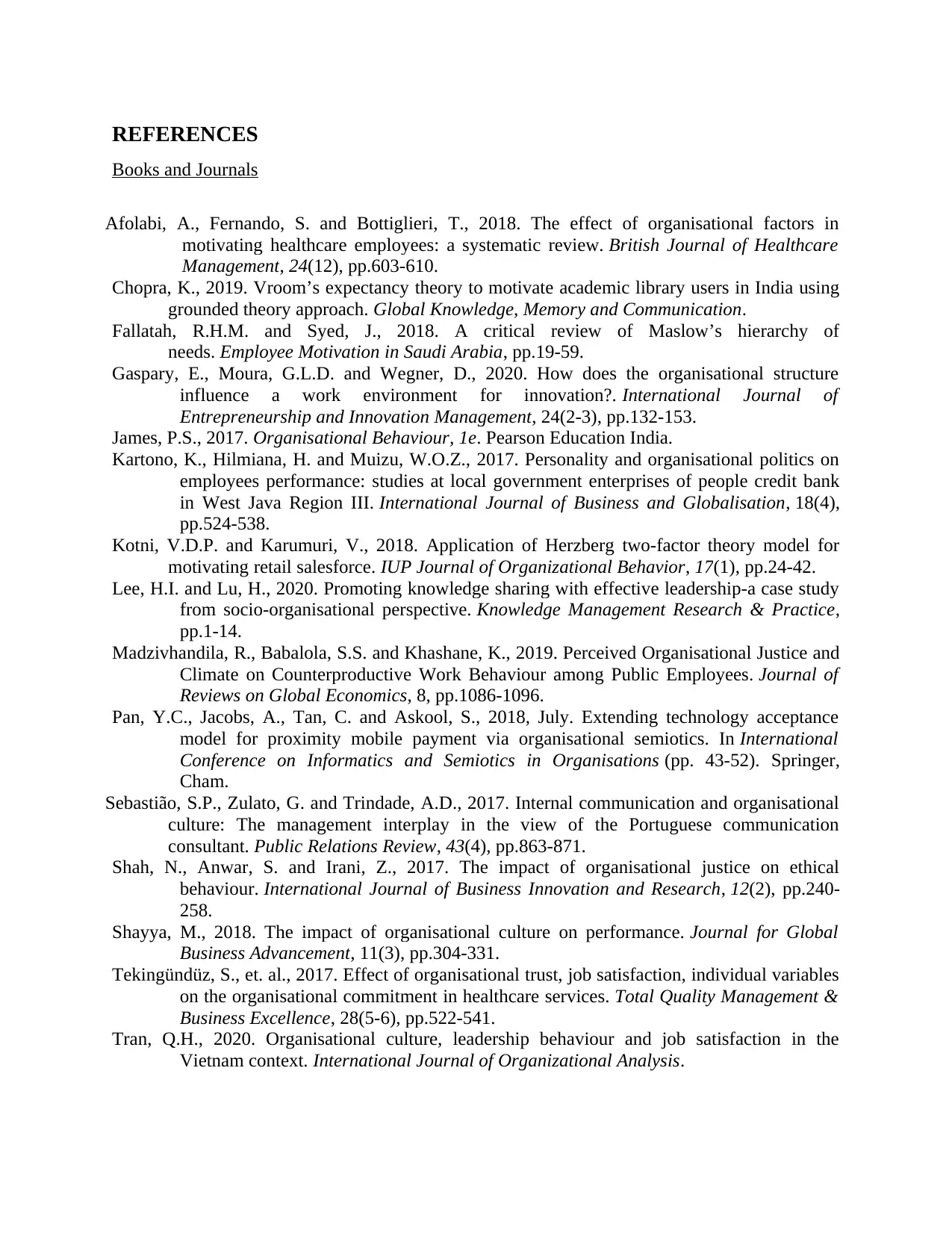
REFERENCES
Books and Journals
Afolabi, A., Fernando, S. and Bottiglieri, T., 2018. The effect of organisational factors in
motivating healthcare employees: a systematic review. British Journal of Healthcare
Management, 24(12), pp.603-610.
Chopra, K., 2019. Vroom’s expectancy theory to motivate academic library users in India using
grounded theory approach. Global Knowledge, Memory and Communication.
Fallatah, R.H.M. and Syed, J., 2018. A critical review of Maslow’s hierarchy of
needs. Employee Motivation in Saudi Arabia, pp.19-59.
Gaspary, E., Moura, G.L.D. and Wegner, D., 2020. How does the organisational structure
influence a work environment for innovation?. International Journal of
Entrepreneurship and Innovation Management, 24(2-3), pp.132-153.
James, P.S., 2017. Organisational Behaviour, 1e. Pearson Education India.
Kartono, K., Hilmiana, H. and Muizu, W.O.Z., 2017. Personality and organisational politics on
employees performance: studies at local government enterprises of people credit bank
in West Java Region III. International Journal of Business and Globalisation, 18(4),
pp.524-538.
Kotni, V.D.P. and Karumuri, V., 2018. Application of Herzberg two-factor theory model for
motivating retail salesforce. IUP Journal of Organizational Behavior, 17(1), pp.24-42.
Lee, H.I. and Lu, H., 2020. Promoting knowledge sharing with effective leadership-a case study
from socio-organisational perspective. Knowledge Management Research & Practice,
pp.1-14.
Madzivhandila, R., Babalola, S.S. and Khashane, K., 2019. Perceived Organisational Justice and
Climate on Counterproductive Work Behaviour among Public Employees. Journal of
Reviews on Global Economics, 8, pp.1086-1096.
Pan, Y.C., Jacobs, A., Tan, C. and Askool, S., 2018, July. Extending technology acceptance
model for proximity mobile payment via organisational semiotics. In International
Conference on Informatics and Semiotics in Organisations (pp. 43-52). Springer,
Cham.
Sebastião, S.P., Zulato, G. and Trindade, A.D., 2017. Internal communication and organisational
culture: The management interplay in the view of the Portuguese communication
consultant. Public Relations Review, 43(4), pp.863-871.
Shah, N., Anwar, S. and Irani, Z., 2017. The impact of organisational justice on ethical
behaviour. International Journal of Business Innovation and Research, 12(2), pp.240-
258.
Shayya, M., 2018. The impact of organisational culture on performance. Journal for Global
Business Advancement, 11(3), pp.304-331.
Tekingündüz, S., et. al., 2017. Effect of organisational trust, job satisfaction, individual variables
on the organisational commitment in healthcare services. Total Quality Management &
Business Excellence, 28(5-6), pp.522-541.
Tran, Q.H., 2020. Organisational culture, leadership behaviour and job satisfaction in the
Vietnam context. International Journal of Organizational Analysis.
Books and Journals
Afolabi, A., Fernando, S. and Bottiglieri, T., 2018. The effect of organisational factors in
motivating healthcare employees: a systematic review. British Journal of Healthcare
Management, 24(12), pp.603-610.
Chopra, K., 2019. Vroom’s expectancy theory to motivate academic library users in India using
grounded theory approach. Global Knowledge, Memory and Communication.
Fallatah, R.H.M. and Syed, J., 2018. A critical review of Maslow’s hierarchy of
needs. Employee Motivation in Saudi Arabia, pp.19-59.
Gaspary, E., Moura, G.L.D. and Wegner, D., 2020. How does the organisational structure
influence a work environment for innovation?. International Journal of
Entrepreneurship and Innovation Management, 24(2-3), pp.132-153.
James, P.S., 2017. Organisational Behaviour, 1e. Pearson Education India.
Kartono, K., Hilmiana, H. and Muizu, W.O.Z., 2017. Personality and organisational politics on
employees performance: studies at local government enterprises of people credit bank
in West Java Region III. International Journal of Business and Globalisation, 18(4),
pp.524-538.
Kotni, V.D.P. and Karumuri, V., 2018. Application of Herzberg two-factor theory model for
motivating retail salesforce. IUP Journal of Organizational Behavior, 17(1), pp.24-42.
Lee, H.I. and Lu, H., 2020. Promoting knowledge sharing with effective leadership-a case study
from socio-organisational perspective. Knowledge Management Research & Practice,
pp.1-14.
Madzivhandila, R., Babalola, S.S. and Khashane, K., 2019. Perceived Organisational Justice and
Climate on Counterproductive Work Behaviour among Public Employees. Journal of
Reviews on Global Economics, 8, pp.1086-1096.
Pan, Y.C., Jacobs, A., Tan, C. and Askool, S., 2018, July. Extending technology acceptance
model for proximity mobile payment via organisational semiotics. In International
Conference on Informatics and Semiotics in Organisations (pp. 43-52). Springer,
Cham.
Sebastião, S.P., Zulato, G. and Trindade, A.D., 2017. Internal communication and organisational
culture: The management interplay in the view of the Portuguese communication
consultant. Public Relations Review, 43(4), pp.863-871.
Shah, N., Anwar, S. and Irani, Z., 2017. The impact of organisational justice on ethical
behaviour. International Journal of Business Innovation and Research, 12(2), pp.240-
258.
Shayya, M., 2018. The impact of organisational culture on performance. Journal for Global
Business Advancement, 11(3), pp.304-331.
Tekingündüz, S., et. al., 2017. Effect of organisational trust, job satisfaction, individual variables
on the organisational commitment in healthcare services. Total Quality Management &
Business Excellence, 28(5-6), pp.522-541.
Tran, Q.H., 2020. Organisational culture, leadership behaviour and job satisfaction in the
Vietnam context. International Journal of Organizational Analysis.
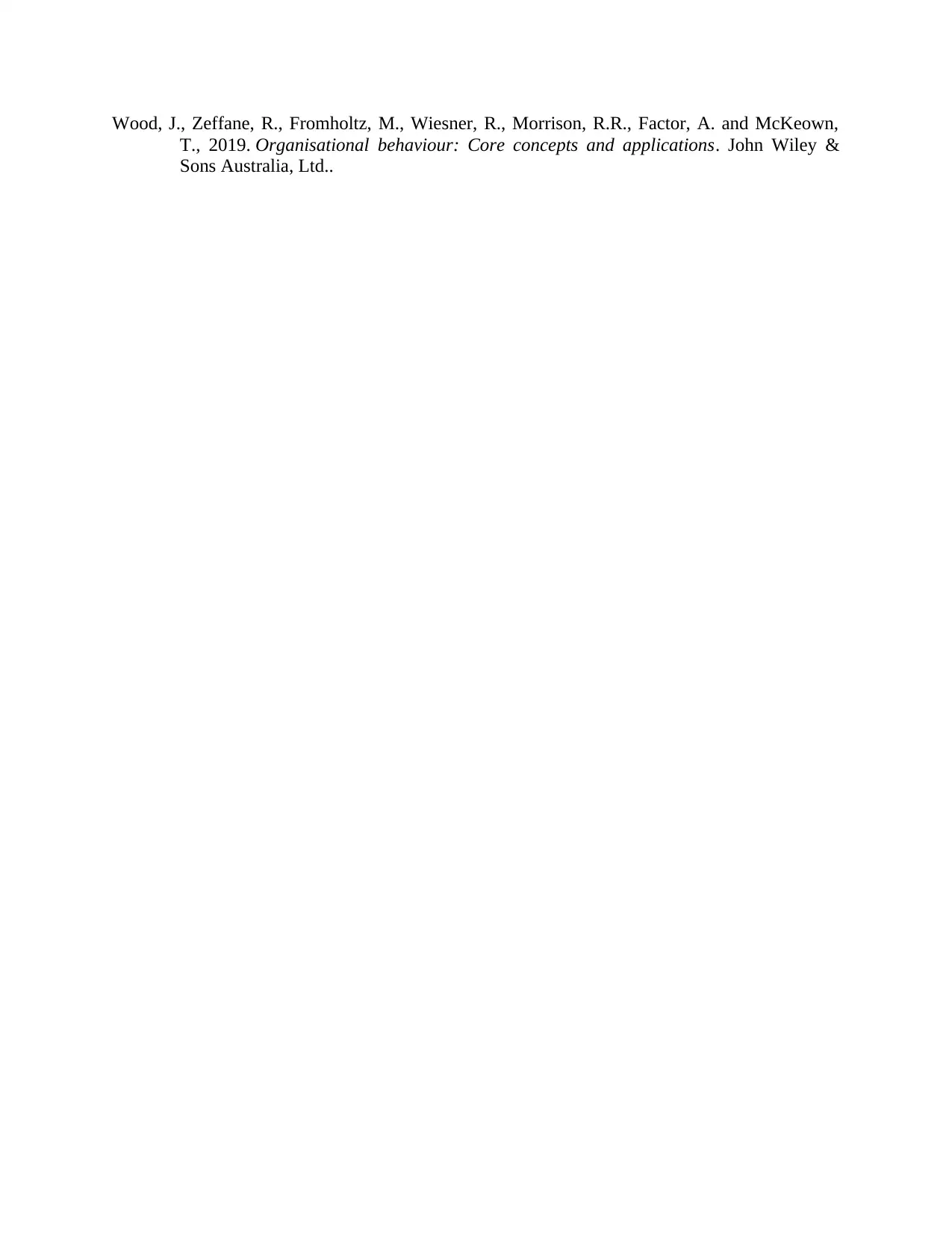
Wood, J., Zeffane, R., Fromholtz, M., Wiesner, R., Morrison, R.R., Factor, A. and McKeown,
T., 2019. Organisational behaviour: Core concepts and applications. John Wiley &
Sons Australia, Ltd..
T., 2019. Organisational behaviour: Core concepts and applications. John Wiley &
Sons Australia, Ltd..
Secure Best Marks with AI Grader
Need help grading? Try our AI Grader for instant feedback on your assignments.


1 out of 24
Related Documents
Your All-in-One AI-Powered Toolkit for Academic Success.
+13062052269
info@desklib.com
Available 24*7 on WhatsApp / Email
![[object Object]](/_next/static/media/star-bottom.7253800d.svg)
Unlock your academic potential
© 2024 | Zucol Services PVT LTD | All rights reserved.





